How to Make an Interactive PowerPoint Presentation: An Expert Guide (Free Downloadable Playbook)
Zhun Yee Chew

Are your PowerPoint presentations lacking impact and failing to engage your audience? You’re not alone. I experienced that before. I used to spend hours carefully crafting the perfect PowerPoint presentations only to be met with disinterested faces.
In a world where attention spans are getting shorter, traditional PowerPoint presentations often struggle to hold the interest of the audience. So here’s the hard truth: unless you adapt and embrace interactivity in your PowerPoint presentations, your valuable hard work and content run the risk of getting lost in presentations.
Fret not, as in this comprehensive guide, we will share with you expert tips on how to make an interactive PowerPoint presentation through interactive animations, transitions, hyperlinks, quizzes, games, and many more.
And perhaps the sweetest part of the deal is that you will also have access to a downloadable playbook of 60+ pages with a wealth of tutorials, templates, cheat sheets, resources and tools to elevate your PowerPoint skills from average to extraordinary through interactive PowerPoint presentations.
Are you prepared to impress those who once found your presentation dull? If your answer is a resounding ‘yes,’ then let’s begin.

What is an Interactive Presentation?
What is an interactive powerpoint presentation.
Interactive PowerPoint presentations are simply PowerPoint presentations that are made interactive to convey information in a more dynamic and engaging manner.
Creating an interactive PowerPoint presentation involves deciding if you want to make your slide content interactive or if you want your audience to interact with your slides.
Interactive PowerPoint presentations can generally be divided into two main dimensions: interaction with slide content through interactive elements and fostering interaction with the audience.

Interaction with Slide Content:
In the first dimension, PowerPoint presentations are made interactive through enhancing the slides content with interactive elements, usually native to PowerPoint.
We will cover interactive elements including:
- Transitions
- Interactive data visualization
- Annotations.
They function to enhance slide interactivity through adding movement to static objects, enabling non-linear slides navigation, as well as adding a dynamic touch to data and information presentation.
Audience Interaction:
In the second dimension, PowerPoint presentations are made interactive through interaction between the presenter and the audience, usually with the help of PowerPoint add-in tools. We will cover:
- Assessments
- Brainstorming
- Collaborative multimedia uploading
Once you have decided which strategy you would like to use, you can then follow these step-by-step guide and the following expert tips to turn your PowerPoint slides into an interactive experience!
Benefits of an Interactive Presentation
The fact that you are still reading this suggests that you don’t need further convincing on the benefits of interactive PowerPoint presentations.
However, if you do, here are some quick statistics:
68% of individuals hold the belief that interactive presentations have a greater potential for being remembered. Webinar Care
This means that a simple action of making your PowerPoint slides interactive has a profound impact on how your presentation is received by the audience. From our years of experience creating interactive PowerPoint presentations, they generally:
- Increases engagement , motivation and knowledge retention .
- Result in better impression and more impactful messaging being conveyed.
- Allow presenters to better tailor their content or offerings to the audience or clients because they can gather real-time feedback .
- Open up room for creative storytelling and showcases.
Interactive Puzzle PowerPoint Templates
Master the tricks to turn your PowerPoint into an interactive experience today!
Expert Tips on How to Make an Interactive PowerPoint Presentation – Before Presenting
1. add animations, but use them judiciously.
The first and most straightforward way of making your PowerPoint presentations interactive is through adding animations to your slides. However, so many people use PowerPoint animations the wrong way. PowerPoint animations are more than just making bullet points or images appear or fly in during your presentation.
Remember, using animations excessively in your PowerPoint presentation will only reduce the appeal and professionalism of your slides. The key is to use them judiciously and purposefully. Before you hit the “Animations” tab, ask yourself, “Does this animation enhance the message I want to convey to my audience?”
2. Add 3D PowerPoint Animations Using PowerPoint Native 3D Stock Elements
Did you know that PowerPoint has free animated 3D elements you can use? We recommend you to try them up to instantly upgrade your presentation from ordinary to extraordinary.
❓ How? Simply go to Insert > 3D models > stock 3D models > animated models. And you will find a wide range of free 3D models ranging from food and animals to plants and characters, and many more. You can also select different animation scenes by heading to the Animations tab.
3. Add Animations With Triggers for Visual Excitement
You can take your PowerPoint animations up a notch by incorporating combining animations with triggers to create interactive pop-ups with extra information . These on-click pop-ups are valuable when presenting a map or when you want to explore specific aspects of an object or topic in more detail. You can also use these pop-ups as markers to alert the audience to exciting elements within different parts of the slide, as such:
❓How? To create on-click pop-ups in your PowerPoint slides, first add shapes that will become clickable buttons, one to “open” the pop-up and the other to “close” the pop-up. Then, add text boxes with extra information you want to show, as well as entrance and exit animations. Combine the animations with “triggers” to activate the animations when the open or close buttons are clicked on.
For a more detailed tutorial on this pop-up animation, download our Interactive PowerPoint Playbook below. 👇
4. add non-linear slide transition.
A quick way to add interactivity to your PowerPoint slides is by using PowerPoint transitions. The first we want to discuss is PowerPoint Zoom. PowerPoint Zoom enables you to zoom in and out of and navigate to specific sections or slides on click, anytime during your presentation.
To access the PowerPoint Zoom feature : click on Insert in the PowerPoint ribbon > Zoom > then choose Slide , Section , or Summary Zoom . Each of these PowerPoint Zoom option serves slightly different functions:
- Slide Zoom: zooms into specific slides
- Section zoom: zooms into specific sections
- Summary Zoom: creates a summary slide for the different slides or sections in your PowerPoint presentation for easy navigation.

❓ How? To set up PowerPoint slide zoom , select the starting slide where you wish to implement the Zoom effect. Next, click Insert > Zoom > Slide Zoom . Here, you can pick the specific slide or slides you want to zoom in on. Click the Insert button, and thumbnails of the chosen slides will be added to your current slide.
Alternatively, for a more manual setup process, you can also set up a navigation menu at the beginning of your presentation that allows the audience to jump to different sections or slides using hyperlinks. Read more in the Hyperlinks section below.
5. Add PowerPoint Morph
Like PowerPoint Zoom, PowerPoint Morph empowers presenters to create dynamic transitions that elevate the visual storytelling in their presentations. But PowerPoint Morph brings storytelling to a whole new level and adds a layer of intrigue to your slides by simulating object transitions or evolution across slides. It functions similarly to animations but offers a smoother and more organic visual experience, without the need for complex setup steps.
Personally, we think the outcomes generated by PowerPoint Morph are more professional and polished-looking as compared to traditional animations. And if you are looking for a more advanced-looking presentation, try this 3D morph animation In PowerPoint .
We’d also like to share with you the numerous applications of PowerPoint Morph contributed by our colleagues and PowerPoint professionals at ClassPoint:
- Moving background
- Rotating wheel
- Rotating cogs
- Photo gallery
- Slide Zoom with Morph
- Creative reveal
- Parallax effect
- Continuous slide transition
- Phone frame
- Movie frame
Gain access to free templates for all these PowerPoint Morph applications and effects by downloading our Interactive PowerPoint Playbook. 👇
6. add hyperlinks – they can link to so many more places than just websites.
Much like PowerPoint Zoom, hyperlinks enable presenters to create interactive menus and navigation structures, allowing audiences to jump to specific slides or sections effortlessly. However, while PowerPoint Zoom primarily focuses on creating a visual and interactive overview of content within a single presentation, hyperlinks extend this capability to connect with external resources, web content, or even additional PowerPoint files.
There are a few ways you could add hyperlinks to your PowerPoint presentation to transform it into an interactive experience effortlessly:

4 Ways You Can Add Hyperlinks to PowerPoint:
- Slide Transition : You can navigate to specific slides in a non-linear manner by simply inserting a hyperlink into your current slide. Head over to Insert > Link > This Document and select the slide you want to link to. You can apply hyperlinks to text, shapes, or pictures.

- Interactive Navigation Menu : Adding an interactive navigation menu at the beginning of your presentation allows clear navigation between different slides and sections in your presentation. Head over to Insert > Link > This Document and select the slides you want to link to.

- Action Buttons : With hyperlinks, you can also create Action Buttons in your PowerPoint presentations to make your PowerPoint slides behave like interactive web pages, allowing users to navigate, explore, and engage with the content in a dynamic and user-friendly manner. Head over to Insert > Action Buttons and choose from the selection.

- Embedded Content : You can also hyperlink your PowerPoint slides to embedded content like PDFs, spreadsheets, and even web pages. Simply click Insert > Object and select the file you would like to embed in your PowerPoint slides. This way, you can remove the hassle of toggling between various files or windows during your presentation.

Expert Tips on How to Make an Interactive PowerPoint Presentation – When Presenting
1. turn your powerpoint slides into interactive quizzes.
The traditional way to add interactive quizzes to PowerPoint is through an unfavorable process of combining complex animations with triggers and hyperlinks. Let’s be honest, it takes an eternity! Even though PowerPoint offers an extensive range of presentation tools, it does not have audience interactivity built at its core.
The good news is, audience interactivity can actually be effortlessly achieved with the various PowerPoint add-ins as listed below:
We will get to polls and games in a bit. For now, let’s show you how you can turn your PowerPoint slides into an interactive quiz in a just a few clicks with PowerPoint add-ins like ClassPoint , which offers a wide range of interactive quizzes from Short Answer and Word Cloud , to Multiple Choice questions.
How to Create An Interactive Quiz in PowerPoint In A Few Clicks
Once you have downloaded ClassPoint, you will have a suite of additional interactive quiz features added to your PowerPoint ribbon.

To turn your PowerPoint slide content into interactive quizzes, simply click on any of the interactive quiz features and add them to your slide. Enter PowerPoint Slideshow mode and you can start the quiz immediately.
2. Run Gradable Assessments inside PowerPoint
With the versatile PowerPoint add-in, ClassPoint , you can also create assessments and collect real-time responses right inside PowerPoint. This is wonderful news for teachers! All you have to do is set up interactive Multiple Choice questions and enable Quiz Mode .

ClassPoint’s Quiz Mode introduces an automatic grading feature to your Multiple Choice questions within PowerPoint presentations created with ClassPoint. This feature not only automates the grading process but also includes automatic star ratings, the option to select difficulty levels, and provides a quiz summary along with an exportable quiz report, making it the perfect tool for classroom formative assessments in PowerPoint!
3. Incorporate Annotations During Slideshow
Another unique way to interact with your PowerPoint slides is through the use of annotations. With annotations, you as the presenter can interact with your slides to draw your audience’s attention to specific details, highlight key points, and tell a more coherent story.
There are 3 ways you could use annotations in PowerPoint:
- PowerPoint Draw Tab: To utilize the PowerPoint Draw Tab, click on the “Draw” tab in your PowerPoint ribbon and begin annotating anywhere on your slides using built-in features like the pen, highlighter, and Ink to Shape. However, please note that PowerPoint Draw only allows annotation in Edit mode.

- PowerPoint Pen Tools: Another option for native PowerPoint annotation tools that permit annotation during slideshow mode can be found by clicking the pencil icon located in the bottom right-hand corner of your screen during a presentation. You can use the pen, highlighter, or laser tools to annotate any part of your slides during the presentation.

- ClassPoint Toolbar: The ClassPoint toolbar serves as an enhanced, free alternative to PowerPoint’s existing pen tools. It offers a broader range of additional annotation features, including text boxes, shapes, spotlight effects, fully customizable pens and highlighters, and more. This enables you to transform your PowerPoint slides into a creative canvas that will captivate your audience throughout your presentation.
4. Run Ice Breakers and Brainstorming Sessions in PowerPoint
The uses of interactive PowerPoint add-ins like ClassPoint are not only limited to teaching and learning. Give your PowerPoint meetings and presentations a strong start with a collaborative and dynamic brainstorming experience.
You can enhance your PowerPoint presentations and turn them into an interactive brainstorming experience by incorporating Word Cloud in PowerPoint, inviting participants to instantly contribute ideas, keywords, or concepts. This allows everyone to dynamically visualize emerging trends and interesting ideas.

❓ How? To start a brainstorming session in PowerPoint, click on the “Word Cloud” button in your PowerPoint ribbon once you have downloaded ClassPoint to add the “Word Cloud” feature in your PowerPoint slides. Then enter PowerPoint slideshow mode to start brainstorming!
5. Add Draggable Slide Objects (And Why It’s Better than Animations!)
Similar to animations, draggable objects allow you to interact with your slide objects freely during slideshow mode, except than you can do so with full control of where you want the slide elements to go!
This dynamic presentation feature adds an element of visual interest that captures your audience’s attention and can be a valuable tool for explaining complex ideas. Moreover, it has the potential to serve various purposes, such as revealing hidden information or acting as a movable marker to indicate your position on the slide content. You can also use it for group drag-and-drop activities, such as matching, categorizing, sorting, and more. You can either perform these actions yourself to provide a visual explanation or engage your audience by letting them instruct the movement of images and text on the slide.
❓ How? Draggable objects is a unique tool that is possible inside PowerPoint with the use of the add-in ClassPoint. Download ClassPoint, free PowerPoint add-in, the select any shape, image, illustration, or text on your slide to become draggable by clicking on “Draggable Objects” in your PowerPoint ribbon, and toggling “Drag enabled” on the side panel.
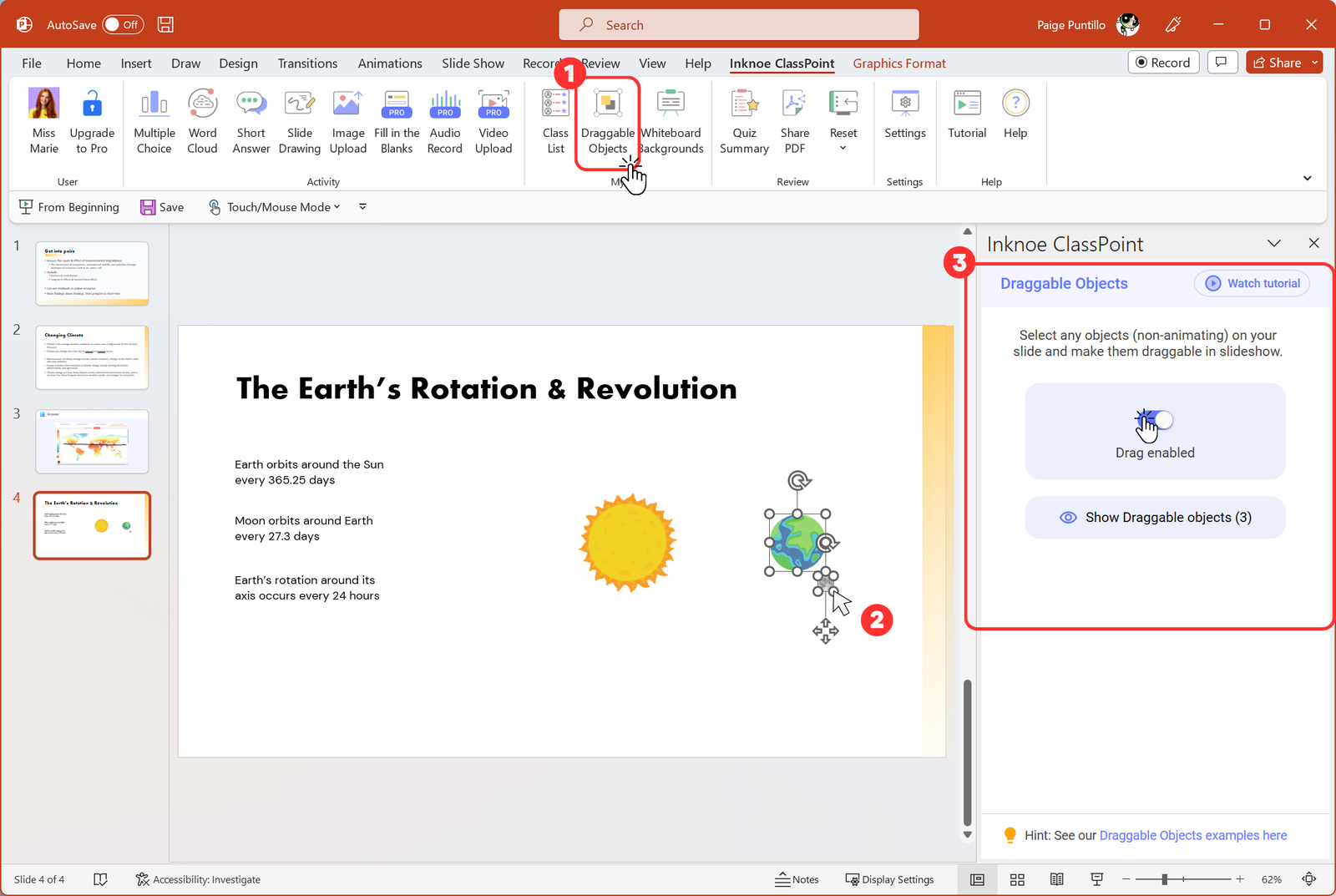
In slideshow mode, click on the draggable objects hand from the ClassPoint toolbar at the bottom of your screen to start dragging your slide objects around!
6. Create Playable Games In PowerPoint (Without Animations or Hyperlinks)
Much like interactive quizzes, PowerPoint games add a layer of interactivity and fun to PowerPoint presentations. However, what sets PowerPoint games apart is their ability to introduce competition through gamification.
Here are 3 ways you can instantly gamify your PowerPoint slides with gamification elements :
- Set Up a Point and Reward System : Define how your participants can earn stars and points, and award stars to them when they have accomplished a goal during your presentation.
- Add Levels and Badges to PowerPoint : Every game benefits from having levels and badges, and your PowerPoint game is no exception. You can create a simple game within PowerPoint by incorporating questions into your slides and defining the points and scores needed to progress to higher levels. When it comes to badges, you have the creative freedom to tailor them to your audience. For example, in an educational setting, badges can be skill-focused, while in a social gathering, they can take the form of fantasy characters that participants aspire to collect
- Add a Leaderboard to PowerPoint : Leaderboards are essential to keep track of scores or points during a PowerPoint game. You can of course create a manual leaderboard using PowerPoint’s tables and hyperlinks, but an easier and more straightforward way of implementing a leaderboard in your PowerPoint is using add-ins like ClassPoint and Vevox .
With these fundamentals of gamification in place, you are now ready to create fun and exhilarating games in PowerPoint.
Here is a full walk-through on how you can create a PowerPoint game in a few simple steps.
If you are an educator, this free trivia PowerPoint template and these 5 interactive PowerPoint game templates tailored for the classroom will be useful for you.
Expert Tips on How to Make an Interactive PowerPoint Presentation – After Presenting
1. run real-time polls in powerpoint.
Think of a memorable presentation you have attended? Did it use live polls? We bet it did! Live polling are especially helpful after a PowerPoint presentation to gather feedback for future improvement.
Traditional poll tools require presenters to switch between tabs during presentation. Thanks to PowerPoint add-ins such as ClassPoint , Mentimeter and Poll Everywhere , this is no longer the case. And by eliminating the need to switch between different applications or tabs, the presentation experience becomes more fluid and engaging.
2. From Static to Interactive Data Visualisation
Incorporating interactivity through data visualization after a presentation concludes is a potent strategy for enhancing audience engagement and comprehension. Once the primary content delivery is complete, you can transition into a dynamic display of data or feedback you have gathered from your audience using interactive charts, graphs, or infographics.
This approach empowers your audience to explore the information at their own pace, dig deeper into specific data points, and ensure a two-way communication between the presenter and the audience. Whether it’s zooming in on specific trends, toggling between different data sets, or going through feedback, interactive data visualization encourages active participation and a deeper connection with the presented information.
We recommend the following 2 ways to display data into your presentation:
- Insert tables, charts and graphs, and add a touch of interactivity through animations.
Below is a list of 10 PowerPoint animations most suitable for different kinds of graphs and charts:
- Embed a website with data you want to go over. I’m not talking about a link that leaves PowerPoint for your default browser, but an actual embedded browser that loads your websites without leaving PowerPoint! Plus you can insert the page as a picture into your slide and start annotating on it!
Now that you have a collection of strategies and tips at your disposal, you are better prepared to leave your old and dusty PowerPoint toolkit behind and embrace these refreshing ideas. Whether your ultimate aim is to create a captivating classroom experience, deliver a memorable business pitch, or simply wow your friends and peers during PowerPoint nights , don’t forget to:
- Add animations, but use them sparingly.
- Make use of non-linear transitions and storytelling.
- Turn simple transitions into stunning visual experience with PowerPoint Morph.
- Make creative use of polls, quizzes and games.
- Make your presentation human with Bitmoji.
- Build anticipation with interactive presentation tools like annotations and drag and drop.
- Try out these 160 fun PowerPoint ideas for your next presentation!
To read more about Interactive PowerPoint Presentations, you can download our Interactive PowerPoint Playbook, which includes comprehensive guides, tutorials on various interactive PowerPoint presentation methods, cheat sheets, and a wide range of resources for mastering the art of creating interactive PowerPoint presentations.
About Zhun Yee Chew
Try classpoint for free.
All-in-one teaching and student engagement in PowerPoint.
Supercharge your PowerPoint. Start today.
500,000+ people like you use ClassPoint to boost student engagement in PowerPoint presentations.
How to make interactive PowerPoint slides for eLearning
- Written by: Hannah Harper
- Categories: PowerPoint design , Effective eLearning
- Comments: 27

Want to build some interactivity into your PowerPoint slides? Here are two easy entry-level ways that you can turn your PowerPoint slides into dynamic and interactive material for eLearning.
How to hyperlink in PowerPoint
Hyperlinks sound a lot more complicated than they actually are. They work like any button or box on a website. By clicking that box you’re sent to another page. So from the ‘Search’ button on Google to the ‘Buy it now!’ on Amazon – you’re already pretty familiar with them.
But did you know you can build them into PowerPoint presentations? In the same way that you can link round a web page, you can link round a presentation.
The advantages of this are that your presentation is no longer linear. You can skip out whole sections and focus on the bits that are relevant. During a test you can link back to the theory for a recap. You can create easily navigable menus just like website home pages.
So how do you create such wizardry?
It’s probably best to hyperlink objects within your presentation. Technically you can hyperlink almost anything in PowerPoint: text (down to a single letter), pictures, objects etc. but it’s best to stick with what looks familiar to your audience (so that’s going to be boxes, arrows, and buttons).
Once you’ve chosen your element, right click and choose the option Link .
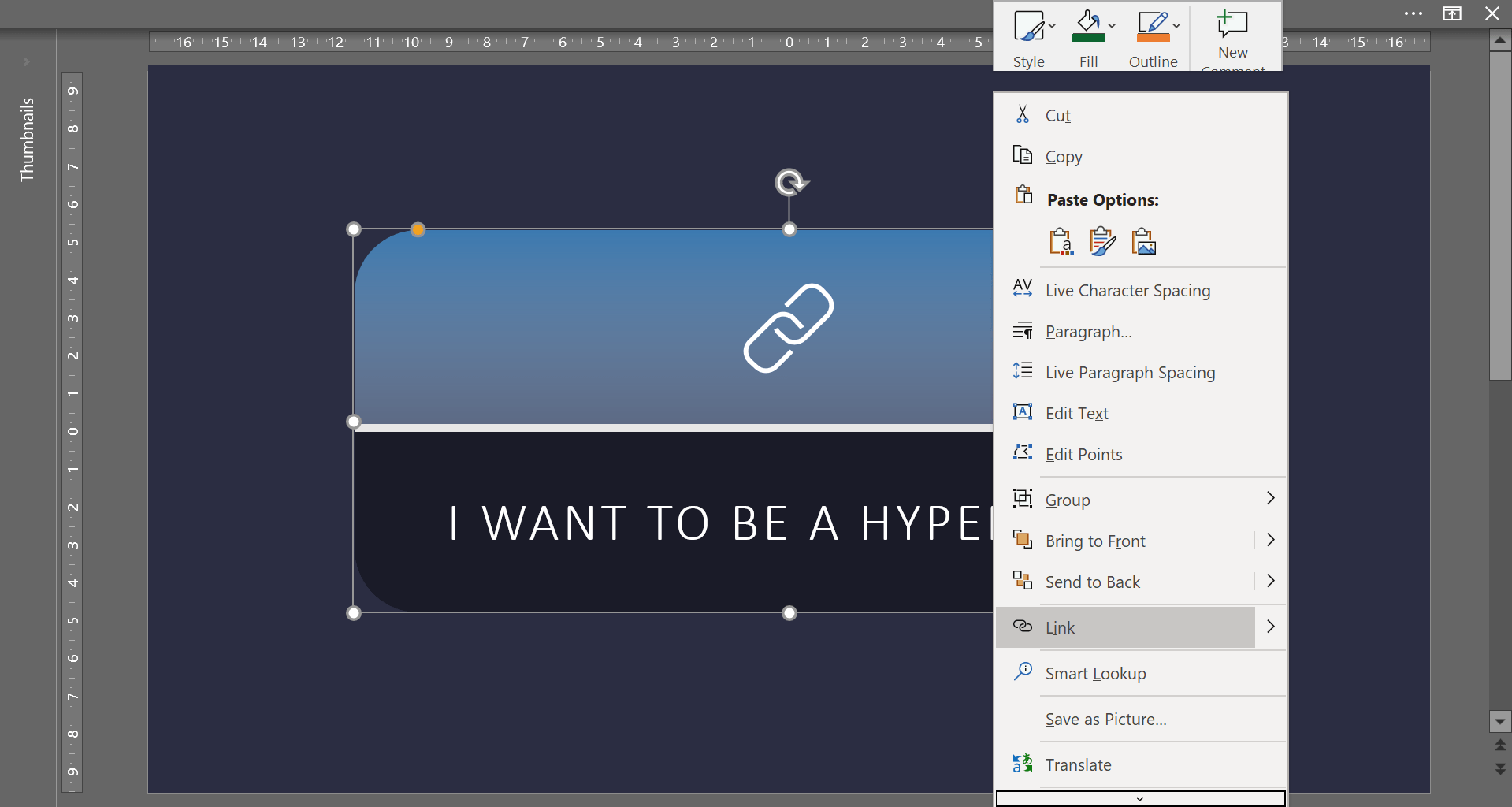
A pop-up window will appear and on the left hand side you want to choose the option Place in This Document . A list of your slides will then appear.
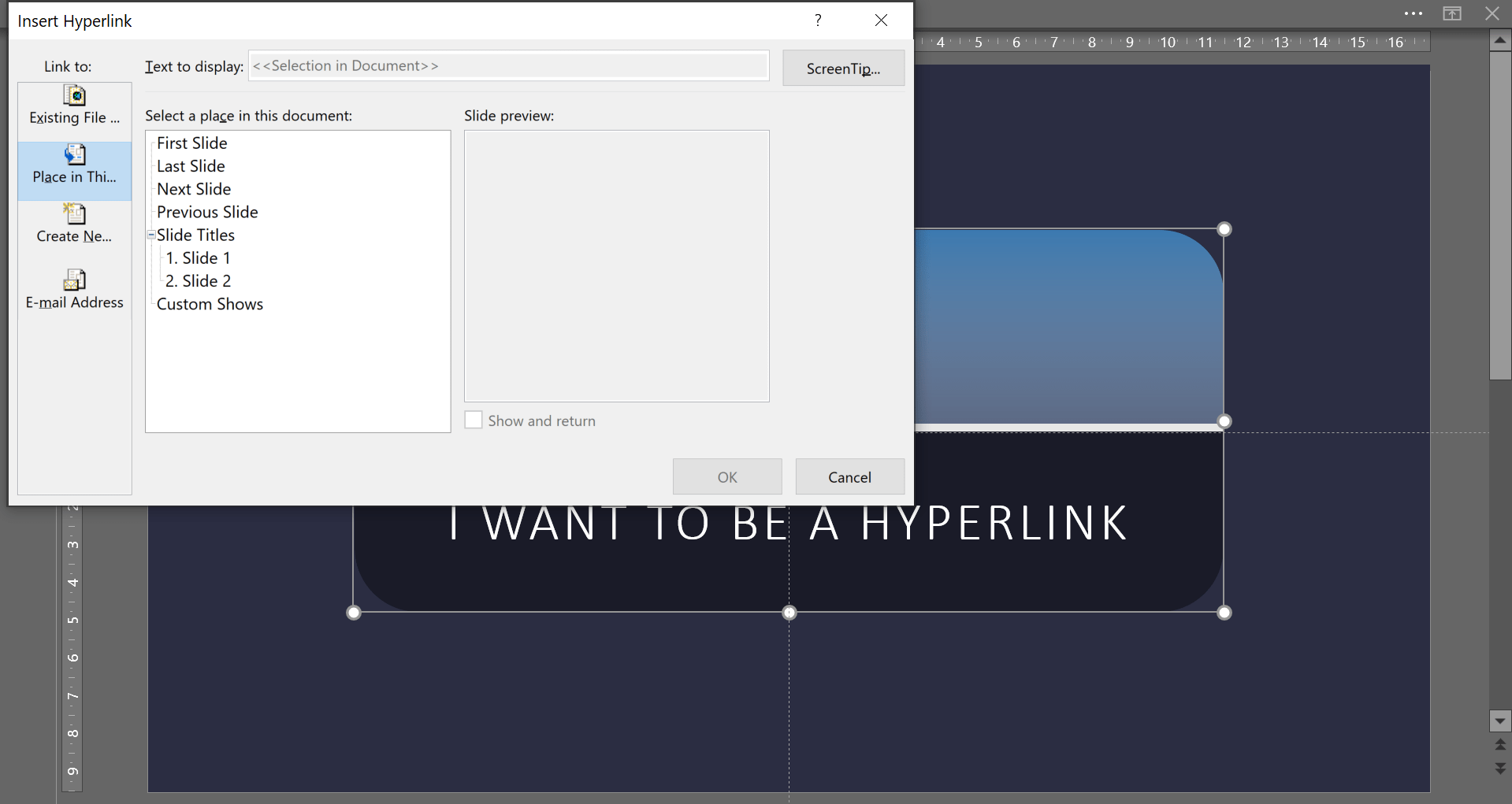
Choose the one you want to link to, hit OK and you’re sorted.
Remember – you can use hyperlinks in PowerPoint in all sorts of ways to navigate around your presentation. It might help to think of it like a web page instead of a presentation. A potential starting point is creating a clickable menu for your slides – find out how by using our guide .
If you’ve got a complicated PowerPoint presentation, your hyperlinks might get overwhelming. It can be difficult to know which slides are hyperlinked and where those links go. Our incredible, free add-in BrightSlide has a super useful tool for getting your links in order. Under the BrightSlide tab select Review (under File & Master ), then click Hyperlinks > Tag Hyperlinks With Comments .
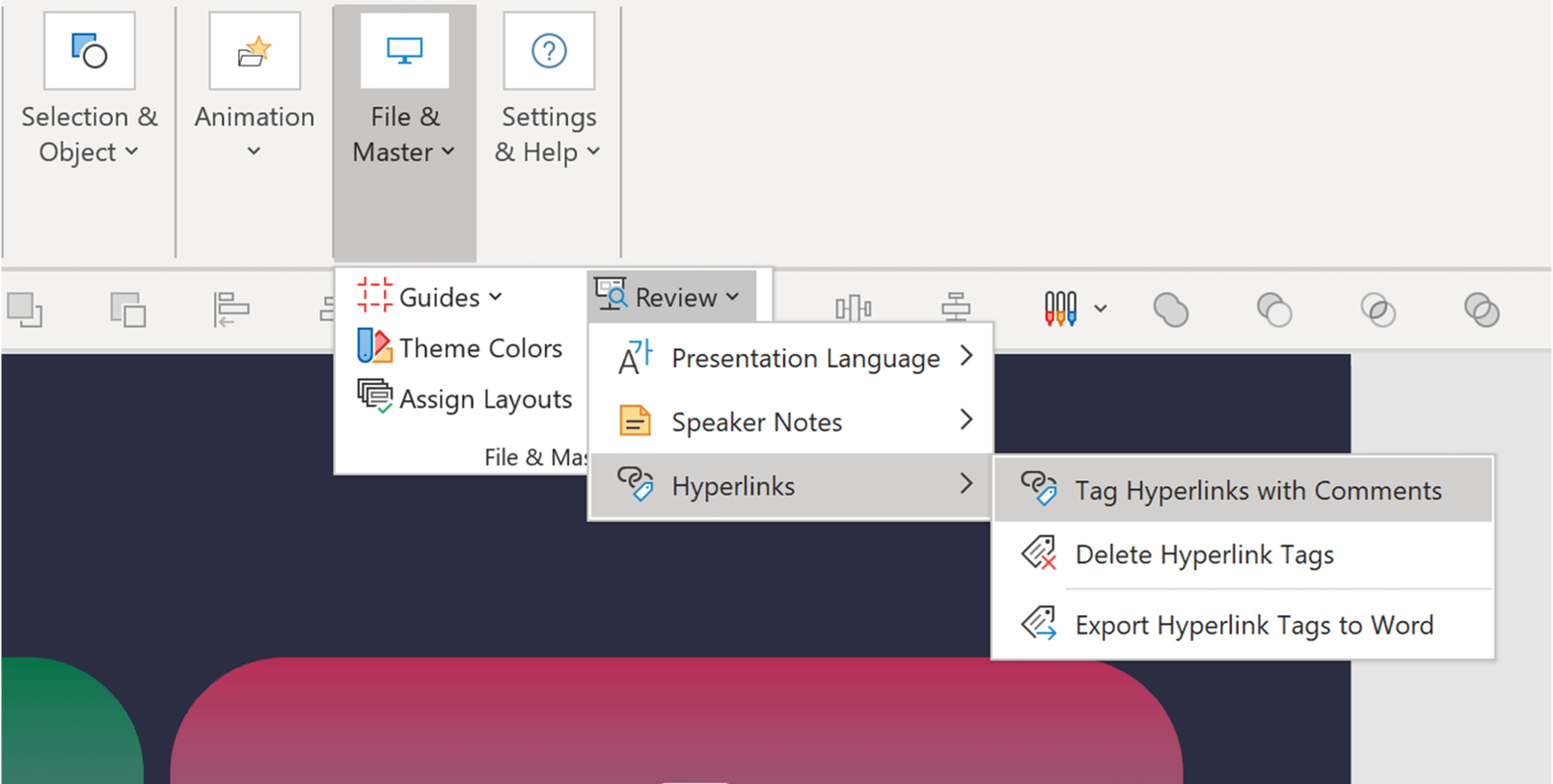
It does what it says on the tin, every hyperlink in your deck will have a comment attached telling you where that link goes. Download BrightSlide here !
Using triggers in interactive PowerPoints
The wonderful thing about triggers, is triggers are wonderful things! They, much like a hyperlink, are applied to a specific element on your slide, and you can add an animation so that something happens when you click that object. Think of this like an internal hyperlink on your slide. You’re staying within the slide itself, but you can click things and have them change in any order – the person viewing the presentation has control.
This can be really useful for building quizzes where your participants have multiple choice questions to answer.
So first of all make your elements (the list of possible answers). Animate them so they appear as you want, then add a Font Color animation. Choose green for the right answer and red for the incorrect answer (if you’re going for the typical look).
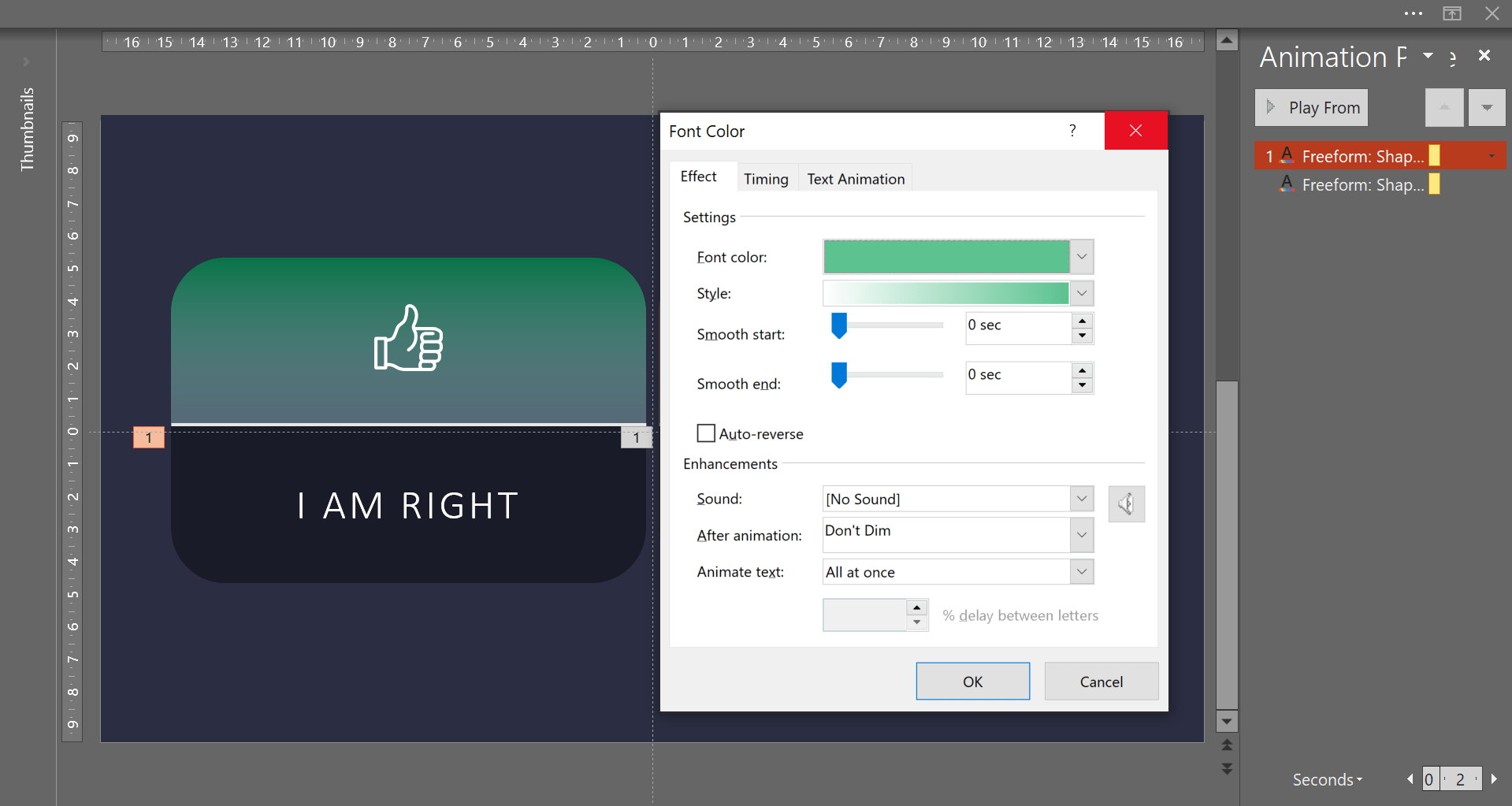
Next go to the Animation tab at the top of the PowerPoint window and make sure you have your Animation Pane open. In the Animation Pane click on one of the Font Color animations – you’ll then see at the top of the Animation tab that you have the word Triggers .
Click on this and you’ll see that you get the option On Click Of . When you select that, you’ll see that all the elements on your slide are listed. Click on the one that matches your element and there you have it. When you play your slide in show mode you’ll be able to click it and the answer will change colour according to whether it’s right or wrong.
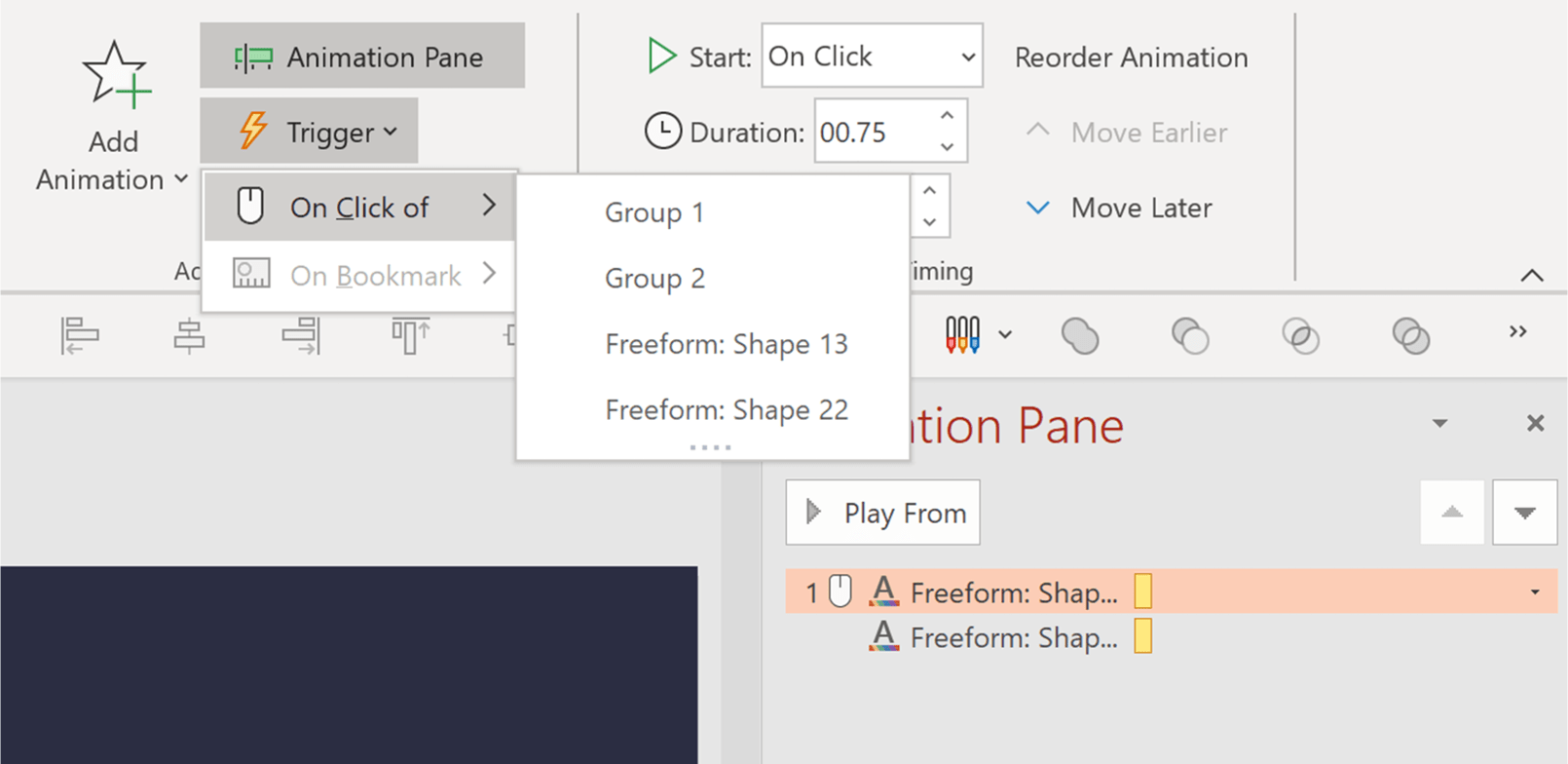
Interactive PowerPoint: Taking it further
You should be able to do a lot in PowerPoint with just hyperlinking and triggers. I’ve given you a few very simple ways to use both of these tools, but as you start to use them for yourselves, you’ll see how many different uses they have.
There will inevitably be things that you want to do that are just beyond the limits of PowerPoint. But there are some great pieces of software that plug into your PowerPoint and give you that option of building more sophisticated interaction. Learn more about PowerPoint triggers in this blog post . Google Slides user? Learn how to create an interactive presentation in Google Slides.
Have any SOS interactivity needs? Post a comment below and we’ll try and sort you out!

Hannah Harper
Principal consultant, related articles, how to get the most out of powerpoint and pdfs.
- PowerPoint design
This article is dedicated to the bit hitting combination of PowerPoint and PDFs, and three particular use cases that will have these two giants working together in perfect harmony: how to convert PowerPoint to PDF on Windows and macOS, how to convert PDF to PowerPoint, and how to insert a PDF into PowerPoint.

Masking effects in PowerPoint: Stencils and animation
Masking effects are a great way to jump-start your image slides in PowerPoint. They not only look great, but also serve many a practical purpose. We've come up with a few ideas for creative ways to combine masking and animation in your presentation.

Masking effects in PowerPoint: Creating stencils
- Comments: 10
Having lots of image slides in a presentation can be great, but sometimes they don't do the heavy-lifting they ought to with your message. Using shapes as stencils to create masking effects in PowerPoint is a really easy and effective way to make your image slides stand out, and communicate something more. Here are three ideas you can try
Thanks Hannah for these tips and suggestions!
Thank you so much for taking the time to create this tutorial. I was chuffed to be able to create interactive buttons by following your instructions. 🙂
Loved your instructions. Made it easy to accomplish what I needed. Excited about exploring more options.
Thanks, great tips. Do you have any tips on embedding video and if possible, overlaying the video with text, pics etc?
It’s great to see you all having a go at interactivity in PowerPoint! Keep experimenting – maybe try playing round with some triggers. We’ve got a great tutorial for that too: https://www.brightcarbon.com/blog/powerpoint-triggers-make-something-happen/
And Lee, you can insert a video like you insert a picture in PowerPoint (just navigate to the’Insert’ tab) here’s a great tool for checking to see what formats work for you: https://www.brightcarbon.com/resources/powerpoint-help/video-embedding-tool-for-powerpoint/
I think this may be beyond powerpoint’s capabilities, but I didn’t know about triggers, either! So I’ll ask: is there any way that the program can keep track of the things a client clicks?
I.e. I want to show a slide for three seconds with an image. The next slide will come up with a set of five choices. I want the client to click on a choice, for the choice to be recorded, and then the next slide shows, regardless of the answer chosen.
I am pretty sure it doesn’t do this, but maybe? If powerpoint doesn’t, can you think of a program that does?
Sounds like an interesting project!
About 90% of that is possible in PowerPoint: you can do everything apart from record the answer. In the Transitions tab you can set your slide to come up for three seconds and advance automatically (uncheck ‘On Mouse Click’). This will them move to the next slide (with your five options). You can then make your five options hyperlinks (if you’re not sure how, just follow the instructions above), and these will navigate the user to a slide of your choosing (they can all be the same).
But if reporting the answer is important, I can recommend a programme called Articulate Storyline: it’s what lots of people use to build out full eLearning decks. You can download a trial version for 30 days if you want to try it out. When you publish in Articulate you can get results reported, the only catch is that you’ll need to upload it to a Learning Management System (or LMS), for the results to be reported to a specific location.
I hope this helps!
I don’t know if this is even possible…
I want to create an interactive calendar using jpeg images. Imagine a preK class using a pocket chart every day, adding that day’s date picture.
So using a trigger button the jpeg image would appear for that day, using a hyperlink you could go to another activity (song, months of the year review, etc.)
But can you tell the program to save today’s jpeg image so tomorrow you only add that day’s and so on?
(sorry, my email address was wrong in the first comment)
This article was excellent with detailed instructional pics. I’m interested in creating free response quiz and also a multiple choice to create a trigger for puzzle piece and melting candle timer. Qtns 1. How to know whether the free response is correct and hyperlink to that’s it slide? Is there a way to use visual basic for this kind of quiz? 2.How to create melting candle timer like word for word worm APP? 3. How to make trigger for multiple choice game where the correct answer will appear on the screen and player must assemble the puzzle pieces before the candle timer melts? 4. Is it better to create free response quiz separate fro multi choice. It should also trigger the puzzle piece to appear after a response is written. HOW to ensure silly answers are not accepted?
I am an experienced producer of powerpoint presentations. I teach languages and use PP to display pages that show objects that play a sound when they are clicked on. They work great on my laptops and students benefit from them. However the study centre’s computers reject any unauthorised software file saving. I cant solve this problem without admin clearance. So I am hoping that there is a way to make my ppp files interact and perform online just like the stand alone version. Any suggestions anybody ?
Hello from France !
First of all, thanks a lot for writing this complet tutorial. But here is my problem : after seeing Prezi, Powerpoint seems so platonic and past history now… But my boss doesn’t want to use Prezi, so here I am to found new options and new ways about using this tool. Can you help me on this ? I’m looking about more animated features.
Thank you again for triggers and hyperlink, I’ll surely use it soon.
Hi Benjamin.
We’re not totally convinced by Prezi .
If you just want to make stuff that looks really cool, check out the Morph functionality in PowerPoint 2016 .
Hi Benjamin, If you want to still have some of the benefits that you get from Prezi you can try Slide Navigator interactive and animated PowerPoint templates. The website is http://www.slidenavigator.com . Hope that helps.
I like this webpage, it is informative and concise. I published a website some years ago explaining how to make PowerPoint interactive for the college where I work. The problem I have found is the fear of PowerPoint and even more fear of trying to make the presentation interactive. Those who are interested seem to get a mental block once they see the work involved. I have felt for a long time that PowerPoint can go a long way to help in training and education when interactive.
I completely agree that interactive PowerPoints can go a long way to help in training and education when interactive. It is a lot of work. There is a website that helps to reduce the amount of work in making an interactive PowerPoint presentation called http://www.slidenavigator.com . I think it can really help college professors.
Or PowerPoint’s new Zoom functionality, if you are using 365. Probably easier.
One word of advice about making things interactive. You have to disable the slide forward clicking in the advanced animation selection. If this is not disabled the slide will advance to the next one. The check box has to be clicked and then you will only be able to move to the next slide or open up other hidden on the slide using the hyperlink. Other presentation programmes from other software organisations such as Libre and Open Office don’t have this disabling function which makes PowerPoint that much more powerful.
Thank you for the great info. Once I build this awesome document how Can I save it so my audience will only see the first page and then navigate using my links?
You can indeed! You need to highlight all your slides and then go to the Transitions tab at the top of the PowerPoint ribbon. On the right-hand side you’ll notice two ‘Advance Slide’ options (On Mouse Click and After 00:00.00]. The ‘On Mouse Click’ option should be checked. If you uncheck it here, the slide won’t advance, and you’ll only be able to navigate using the hyperlinks you’ve added!
You can then save it as a standard .pptx file, or you can save it as a PowerPoint Show file (.ppsx) if you just want your audience to launch the presentation (without seeing the edit view).
I hope this does the trick for you!
Hi Hannah, I’m a bit late to the party here, but am trying to save an interactive ppt. as an interactive PDF for upload to a training Sharepoint. However when the PDF launches it also has the option to scroll through all the pages, rather than only progressing via hyperlinks – how do I do set this up to only be able to move on via links?
I am designing quizes for pre-schoolers using powerpoint slides. I have created hyperlink of a text box to another slide. When I do a right click the textbox, it opens up to a list of options. I have to select open hyperlink. How to bypass this step? Is there anywhere to click on the text box and open up to another slide directly?
Thanks for these tutorials. It really enhances my skills in designing PowerPoint presentations.
Quite hapy with built in annimations but looking for different ready made Aware of companies like Envato but just want to buy animationsd (advance)
Thank you so much, this is great
When creating an interactive e-learning, how would you handle transitions to the next slide? Is there a way to set triggers for that as well (like clicking on an image that says “next”?)
How do I make shapes that my audience can click and drag around. I want them to virtually be able to complete a jigsaw puzzle.
Nice. I like this post very much.
Leave a Reply Cancel reply
Save my name and email in this browser for the next time I comment.
Join the BrightCarbon mailing list for monthly invites and resources
We were notified on Friday that we’ve been successful in our renewal bid. They were particularly complementary about our presentation and claimed it was one of the best they’ve had. Greg Tufnall Siemens

Home Blog Presentation Ideas How To Make a Presentation Interactive
How To Make a Presentation Interactive
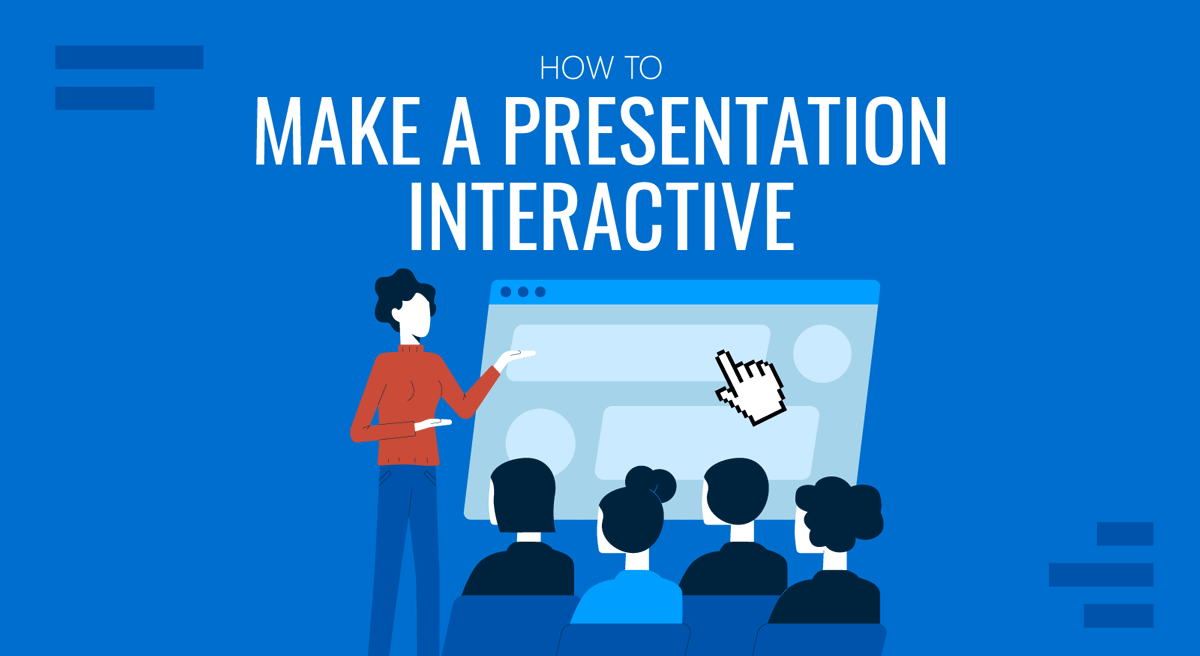
This article provides a short list of proven techniques for adding interactivity to your presentations. Based on our experience and available research, we know applying them will enhance your presentation experience.
Table of Contents
Definition of Interactive Presentation
Benefits of interactive presentation, interactive presentation techniques, recommended templates for interactive presentations.
An interactive presentation actively engages the audience, transforming them from passive listeners into active participants. It incorporates various elements that invite audience interaction, encourage learning and discussion.
- Interactive presentations generate connection, bringing audiences and presenters closer.
- They enhance comprehension, simplifying complex concepts.
- They boost engagement, keeping audiences active and interested.
- They encourage cooperation, promoting collaborative learning and problem-solving.
The following list is a suggestion of audience interaction techniques that, in our experience, helped presenters make their presentations interactive. They all present an actionable example that can be easily implemented in your next PowerPoint presentation .
Use of Icebreakers
In recent years, researchers have theorized that Icebreakers help establish a conducive communication environment, favoring participation. Effective icebreakers can range from simple questions to fun activities to break down barriers and encourage interaction. The key is to choose an icebreaker that aligns with the audience and the topic of the presentation.
Icebreaker examples
We present two examples of the same technique based on the context of the presentation delivery method.
Scenario 1 – Physical Audience (in the Context of a Summit)
In summits, the audience is gathered for a shared interest. So, the hypothesis is that the people in the room, ready to listen to the presentation, have some interests in common. The presenter can break the ice with a simple “know the people around you.” Each participant should present themselves to the person at the right and the left and ask them the purpose of their assistance.
The presenter will then share the 3 “possible answers,” introducing how the presentation will cover those interests. If time is well measured, it can even do a “rise the hands” round to roughly estimate the answers.
This technique requires good control of the room, so it is important to constantly gauge the possible distraction generated vs the communication effect that wants to be reached. We suggest our subscribers present quickly, clear the icebreaker exercise, and invest time in the wrap-up (post-exercise) activity.
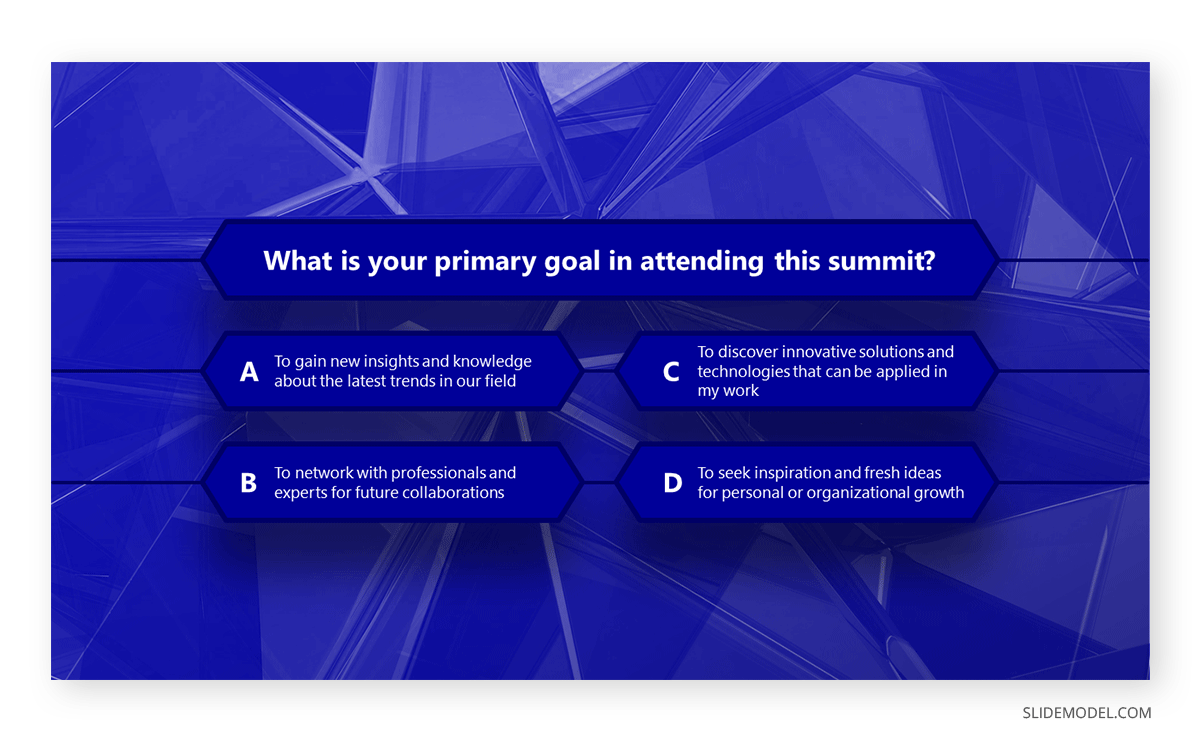
Scenario 2 – Virtual Audience (in the context of a course)
During virtual presentations (like in Google Meet or Zoom ), the interaction between participants requires separate meeting rooms or moderated chat, which incurs complexity and additional effort. So, our experience in virtual presentations shows that a single round of attendee introductions is a good icebreaker for the audience-presenter pair.
The main task the presenter needs to prepare is to define beforehand the number of people that will introduce themselves and the 3 questions they should answer about them.
For example:
- What’s your name? (or any demographic that might fit the audience)
- What do you expect from the presentation?
- Do you have a specific question or topic you would like the presenter to address?
This technique of micro-interactions increases the audience’s affinity with its remote peers and triggers curiosity. For the presenter, it sets a standard of expectations to focus on during the speech. [3]
Incorporation of Multimedia Elements & Other Interactive Presentation Ideas
According to audience studies , incorporating multimedia elements into presentations significantly enhances audience engagement . This technique uses videos, reels, TikTok, audio clips, animations, memes, and images to convey information more effectively. These elements can simplify complex concepts, stimulate discussion, and maintain audience interest. They also cater to different learning styles, ensuring a more comprehensive understanding of the presented material.
Use of Non-linear Flow
Non-linear flow in interactive presentations allows for a flexible, audience-driven progression. It consists of allowing the listener to decide the path of the presentation. This technique enhances engagement by adapting to audience responses. Two studies ([1],[2]) conclude that the use of a non-linear presentation reinforces learning and improves understanding of concepts and results.

Storytelling Approach
The storytelling approach involves weaving a narrative around your topic, connecting facts and figures with characters and plots. This method engages the audience emotionally, stimulating their imagination, making it more relatable and memorable, and enhancing their understanding of the subject matter. The interaction materializes between the message and the emotions of the receiver.
Do not misunderstand the usage of storytelling presentations as merely fictional creative plots. The presenter needs to create a story that delivers the message and also, is backed up with arguments or data.
Storytelling Example
For instance, imagine a mid-manager working on customer trends and behavior analysis in a retail company. In the previous quarter, numbers show a decrease in the sales of brewed coffee. The trends and survey analysis show that consumers prefer to brew at home.
So, instead of just showcasing numbers, the presenter elaborates on a customer persona (“Emily”) and creates a story about Emily’s regular day and decision-making process.
“Emily is a hard-working mom of 2 boys. She has a white-collar job, 9 to 5, in a big city. She is a conscious mom about their children’s nutrition and makes her grocery every morning in our stores. She values our quality and freshness. As part of her daily routine, she picks a fresh coffee from our store barista and quickly covers her shopping list., ready to deliver the goods at home and run to her job.
Her morning routine has recently been affected since Emily’s budget has seen an increase in groceries, and a detailed analysis of cost benefits has replaced the almost automatic process of selecting top-of-the-line healthy products. Prices have seen alterations due to inflation and have hit the shelves. Emily’s routine has changed so that she does not even take her “to go coffee”; she decided to brew at home.”
This story is more relatable and can trigger the audience’s experience about the topic. This is no bidirectional communication but generates an internal action in the audience.
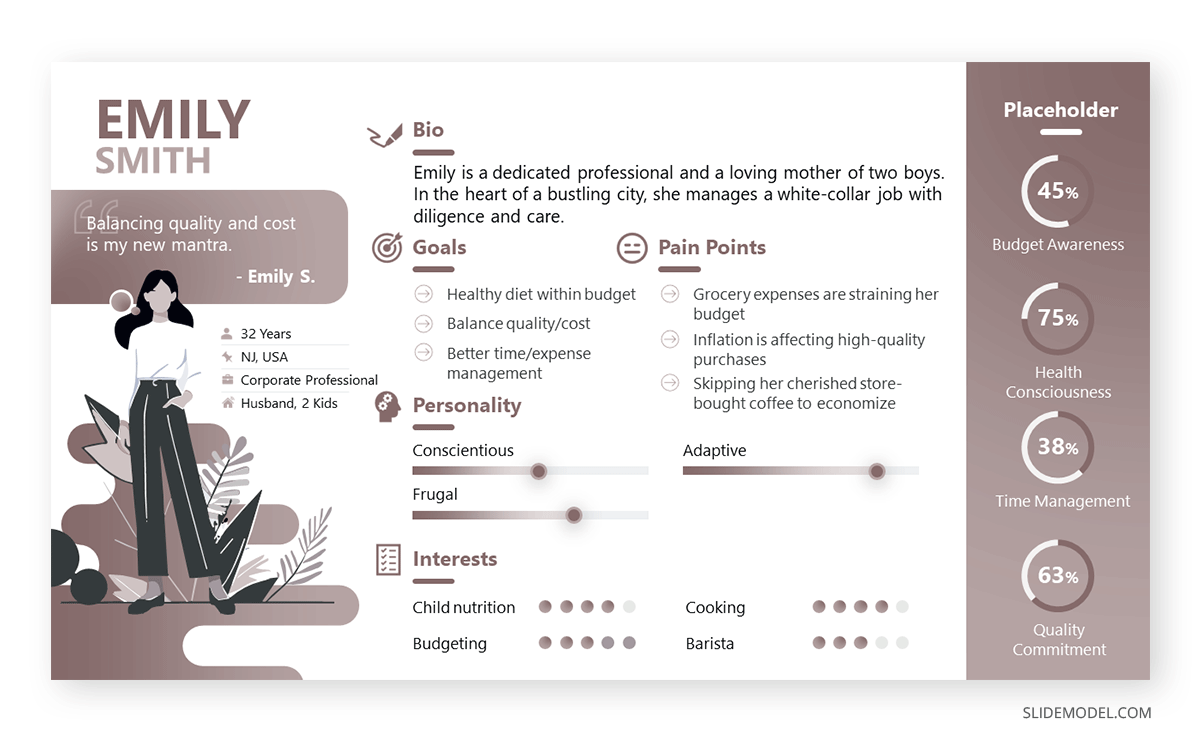
Use of Q&A and Discussion Sessions
Question and Answer (Q&A) sessions and discussions complement interactive presentations. They provide a platform for the audience to drill down into concepts and exchange ideas. This methodology promotes dynamic involvement, inviting passive spectators to become active participants. Moreover, the presenter can extract invaluable insights from these sessions, transforming the presentation into a reciprocal learning experience. For further reading and techniques of Q&A sessions, please check our post on how to moderate questions and answers .
Quizzes and Polls
In interactive presentations, quizzes and polls are frequently employed to receive input from the audience at scale. Using technology, you can get quick answers to a grid of questions predefined or even built during the presentation itself. The audience input is received and quickly processed to share in a summary. Results can then be discussed during the presentation.
Quizzes and Polls Examples
As technology for this technique, we suggest using Microsoft Forms or Google Forms. Booths are proven technologies that can be accessed from almost every network and guarantee you will not fail during your presentation. This tool reduces the risk of having a glitch failure.
If you have an Office 365 subscription, you can use Microsoft Forms, which integrates with PowerPoint to show the results of a poll or quiz.
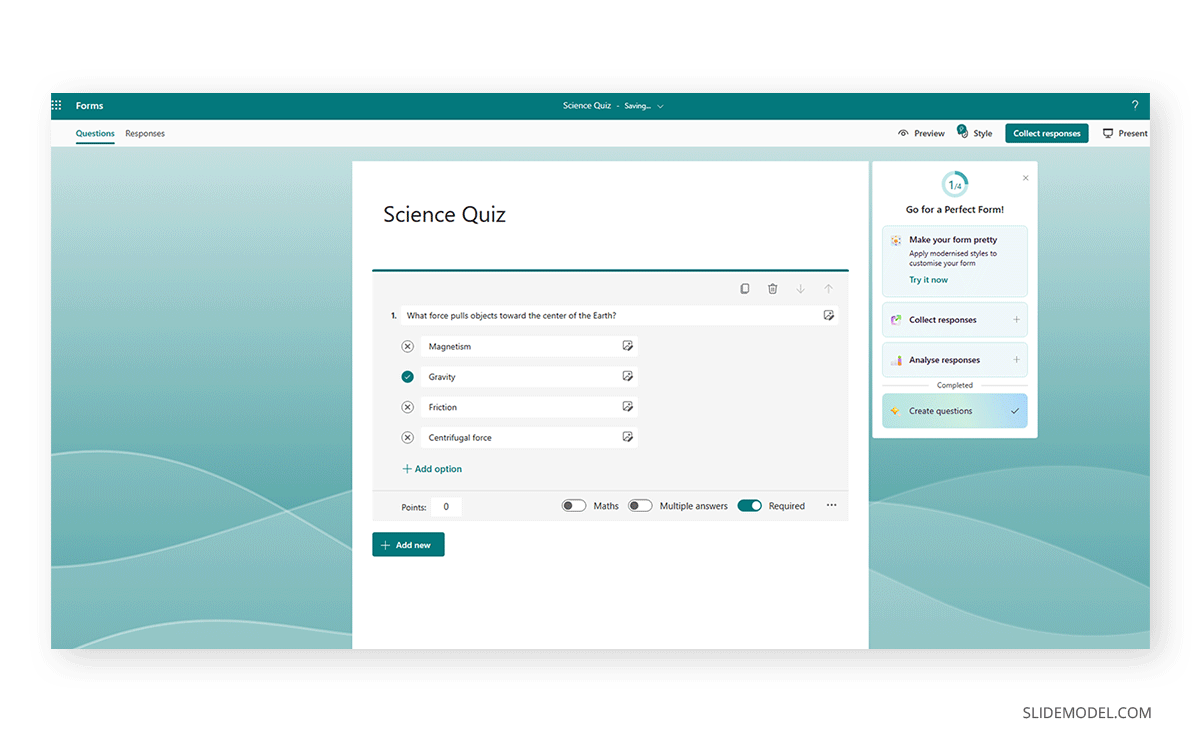
If you use Google Forms, even though you do not have direct interaction, you can use the web viewer add-in of PowerPoint and, after some time, edit the presentation, refresh the preview, and show the examples.
Here is a list of interactive presentation ideas & templates that you can use in PowerPoint or Google Slides.
1. Interactive Jeopardy Game Template for PowerPoint & Google Slides

Welcome to Jeopardy! If you intend to make a memorable presentation and evaluate your attendees’ knowledge of the topics you disclose, this is the ideal resource to make a presentation interactive.
Use This Template
2. Quiz Maker for Interactive Presentations Template
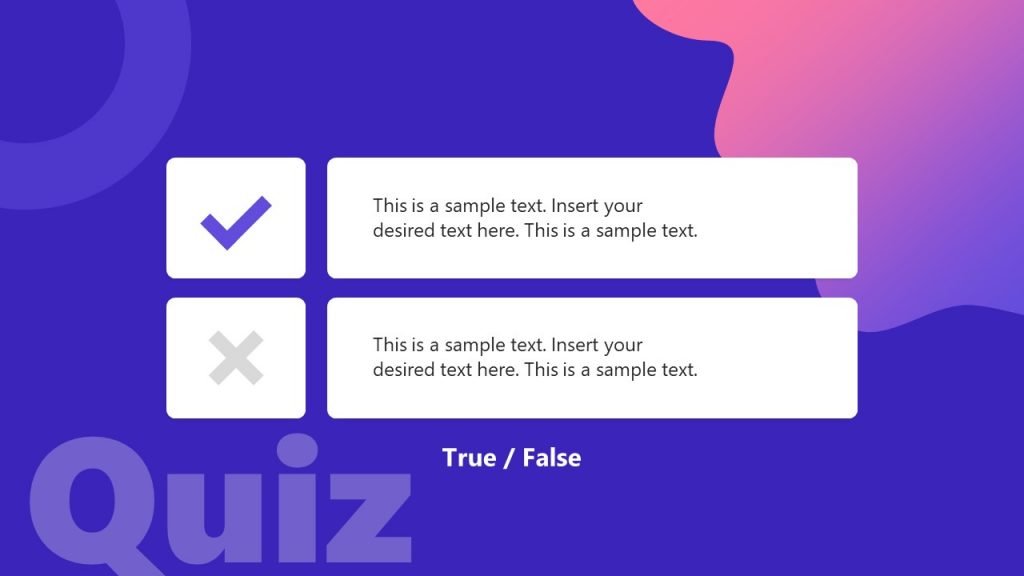
When looking for how to make presentations interactive, this slide deck with a quiz theme can bring light to training sessions or even inspirational presentations. Easy to edit, you can build expectation with multiple-choice format, or work with true/false statements.
3. Six Thinking Hats PowerPoint Template for Interactive Presentations
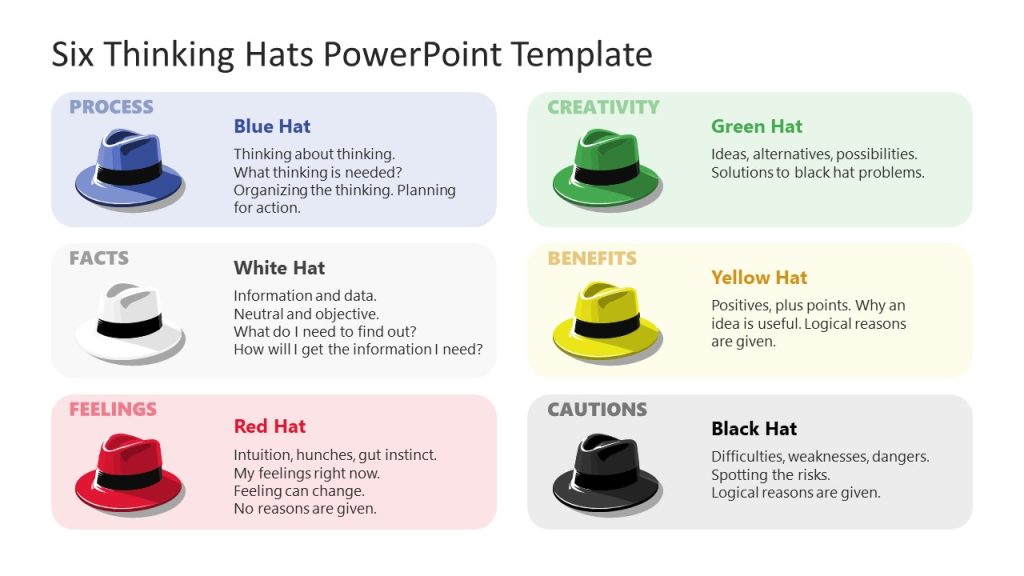
Induce interactive activities for presentations by implementing this creative thinking template featuring the Six Thinking Hats model. It is ideal for teams to discuss a problem from different points of view.
4. Futuristic Concept Roadmap for Interactive Presentation Ideas
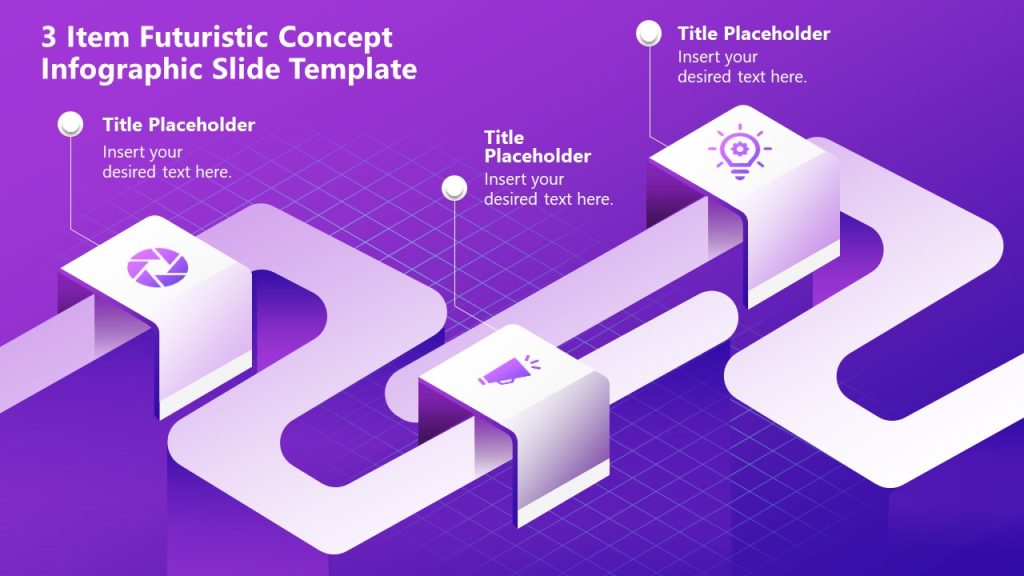
When looking for how to create an interactive PowerPoint presentation, this roadmap template stands out by its highly detailed graphic aesthetic, which makes facts easier to remember. Participants can add their insights to collectively build a roadmap for the organization, highlighting 3 key milestones.
We presented several methods to make your presentation interactive. You can navigate our presentations gallery and choose professional PowerPoint templates to apply these new techniques.
- Das, Anup & Dutta, Bidyarthi. (2002). Presentation of Results of Research: Linear and Non-Linear Forms.
- Rumpa, Lantana & Sampelawang, Petrus & Lolang, Enos & Tangkeallo, Daud & Rubianus,. (2018). NON-LINEAR PRESENTATION ON STUDENT PERFORMANCE: APPLYING PREZI ON ENGINEERING EDUCATION.
- In-person vs. virtual conferences: Lessons learned and how to take advantage of the best of both worlds

Like this article? Please share
Presentation Approaches, Presentation Ideas Filed under Presentation Ideas
Related Articles

Filed under Design • March 27th, 2024
How to Make a Presentation Graph
Detailed step-by-step instructions to master the art of how to make a presentation graph in PowerPoint and Google Slides. Check it out!

Filed under Presentation Ideas • February 29th, 2024
How to Make a Fundraising Presentation (with Thermometer Templates & Slides)
Meet a new framework to design fundraising presentations by harnessing the power of fundraising thermometer templates. Detailed guide with examples.

Filed under Presentation Ideas • February 15th, 2024
How to Create a 5 Minutes Presentation
Master the art of short-format speeches like the 5 minutes presentation with this article. Insights on content structure, audience engagement and more.
Leave a Reply
Log in / Sign up
Don't have an account? Sign up --> Forgot Password? --> -->
Log in directly with a Google account, no need to register
Already have an account? Log in
Reset Password
How to Make an Interactive PowerPoint: Comprehensive Guide

In today's digital age, presentations have evolved beyond static slides. Interactivity is the name of the game, ensuring engagement, retention, and a memorable experience for the audience. Whether you're an educator, a business professional, or a student, making your PowerPoint presentation interactive can elevate it to the next level. In this guide, we'll walk you through the steps to create an interactive PowerPoint presentation and introduce you to a game-changing tool: the AI PowerPoint generator by Smallppt.
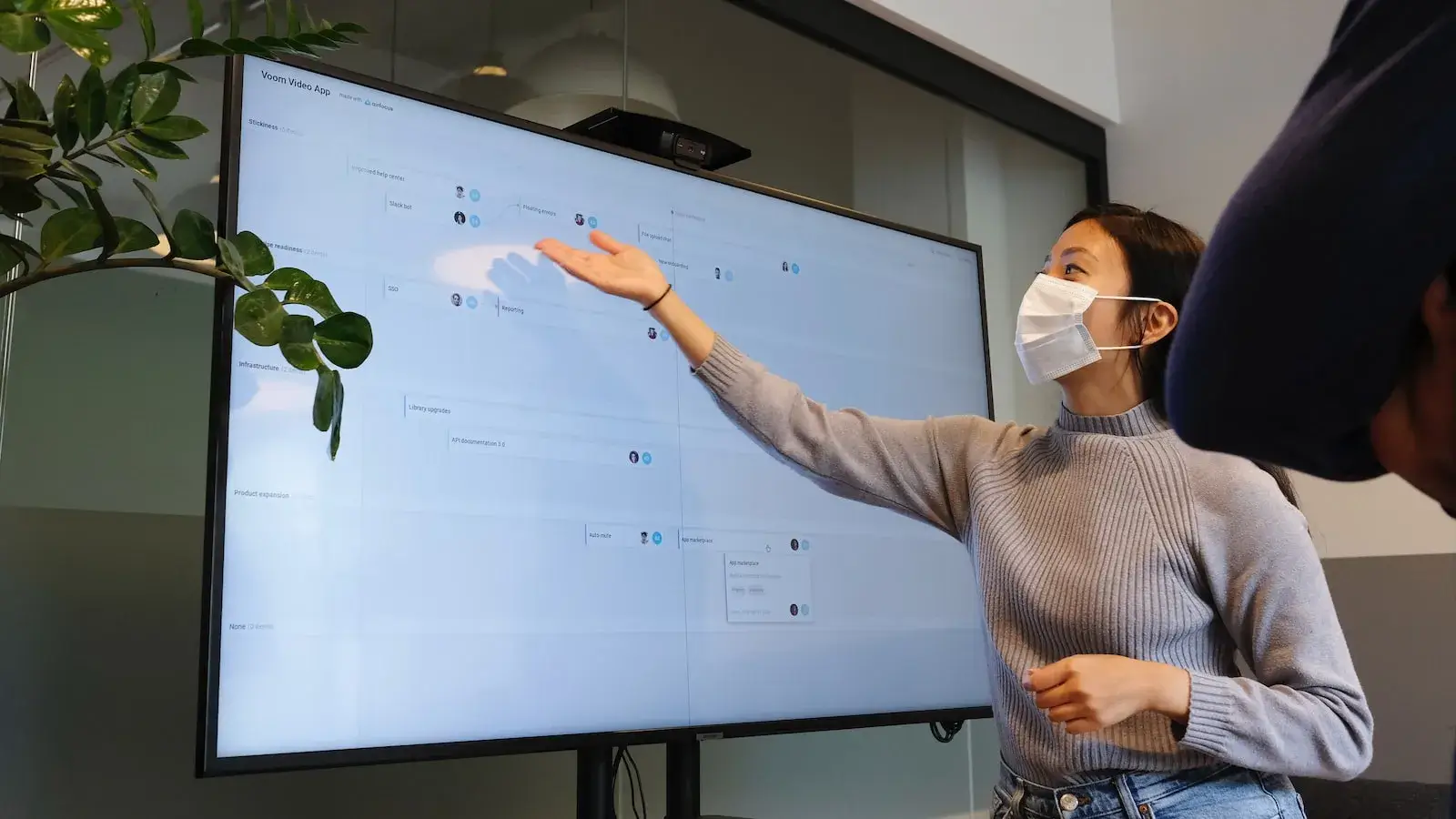
1. Understanding the Importance of Interactivity
Engagement: Interactive elements keep the audience engaged, ensuring they pay attention throughout the presentation.
Retention: Interactive presentations can enhance memory retention, making your content more memorable.
Flexibility: Interactivity allows for non-linear presentations, letting the presenter jump to different sections based on the audience's responses.
2. Basic Steps to Make Your PowerPoint Interactive
Hyperlinks: One of the simplest ways to add interactivity. Link text or images to other slides, documents, or even websites.
Action Buttons: These are built-in buttons that can take you to the next slide, the previous slide, the last slide viewed, and more.
Trigger Animations: Set animations to play when a specific object on your slide is clicked.
Interactive Charts and Tables: Use these to display data in an engaging manner, allowing viewers to interact with the information.

3. Advanced Techniques for Enhanced Interactivity
Embedding Multimedia: Incorporate videos, audio clips, and even interactive quizzes to make your presentation stand out.
Zoom for PowerPoint: This feature lets you easily jump to and from specific slides, sections, and portions of your presentation in any order.
Morph Transition: This can smoothly animate objects across slides, giving a sophisticated look to your presentation.
4. The Power of AI in Enhancing Interactivity
Smallppt's AI PowerPoint Generator: This tool can analyze your content and suggest areas where interactivity can be added, saving you time and ensuring optimal engagement.
Customization: The AI tool allows for customization based on the audience's preferences and needs.
Continuous Learning: The more you use the AI generator, the better it gets at understanding your style and preferences, making suggestions even more tailored over time.
5. Tips for a Successful Interactive Presentation
Test Your Presentation: Before presenting, always test the interactive elements to ensure they work as intended.
Keep It Relevant: While interactivity is great, ensure that every interactive element you add serves a purpose and enhances the presentation's message.
Seek Feedback: After your presentation, gather feedback to understand which interactive elements were most effective and which ones might need tweaking.

Making your PowerPoint presentation interactive is not just a trend; it's a powerful tool to make your content more engaging and memorable. With the basic and advanced techniques outlined above, coupled with the power of Smallppt's AI PowerPoint Generator, you're well on your way to creating presentations that captivate your audience from start to finish. Remember, in the world of presentations, interactivity is the key to engagement. Embrace it, and watch your content come to life!

Title/Email address/Description is not null!
You’re using an older browser version. Update to the latest version of Google Chrome , Safari , Mozilla Firefox , or Microsoft Edge for the best site experience.
- eLearning Blog
- eLearning Basics
- Instructional Design
- Corporate Training
- Course Selling
- Manufacturing
- Products iSpring Suite iSpring Learn
- Use Cases Onboarding Compliance Training Induction Training Product Training Channel Partner Training Sales Training Microlearning Mobile Learning
- Company About Us Case Studies Customers Partnership Course Development Contact Us Academy Blog Webinars Guides
- Community Academy Blog Webinars Guides Experts on iSpring
- Language EN English Français Deutsch Español Italiano Nederlands Português Polski 中文 日本語 العربية Indonesia
- Shopping Cart
Free Online eLearning Conference | May 2nd–3rd
iSPRING DAYS 2024
Seize the human-centric future of learning
How to Create an Interactive PowerPoint Presentation

Table of Contents
PowerPoint presentations are one of the most popular educational resources nowadays. Having been so for quite some time, they might look a bit old-fashioned and not as engaging as we would like. However, there’s a surefire way to make them much more dynamic – create interactive slides.
In this article, you’ll learn what interactive elements you can add to your PPT presentation, how to do this in PowerPoint step by step, and how to keep the audience’s attention by making the learning experience even more exciting and interactive with iSpring Suite. Let’s get started.
What Makes a PowerPoint Presentation Interactive?
3 Ideas for Interactive PowerPoint Presentations
An Easier Way to Create Interactive Learning Materials
There are many ways to make your presentation interactive. Some require only PowerPoint functionalities, while others require a different tool or a PPT add-in. Here are some of the most common ways to add interactivity to your PPT slides:
- PowerPoint triggers and animations
- Multimedia: visual content, audio files, web pages, and videos
- Interactive software simulations
- Mini games
- eLearning interactions
- Interactive quizzes
- Interactive role-play simulations
3 Ideas for Making Presentations Interactive with PowerPoint
PowerPoint lets you create lots of learning content that will keep your audience engaged, by using functionalities like on-click interactions, pop-up menus, and tests with branching scenarios. Here we’ll show you how to do that and ways to make this process even easier and more effective.
Check out a demo that includes some of these content types:
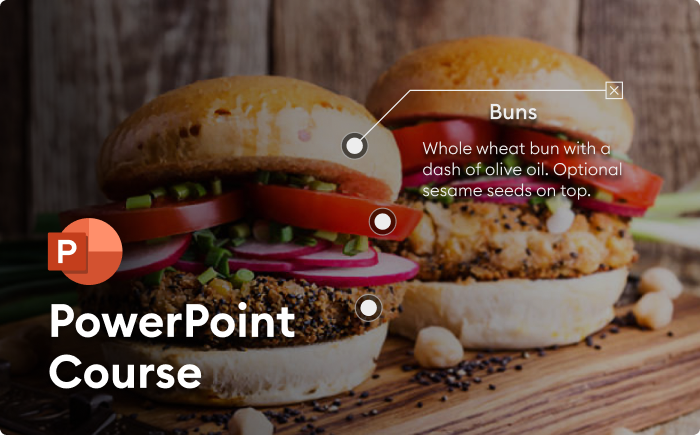
Follow our step-by-step guides to create one of these content types for your interactive presentation.
Idea #1: PowerPoint triggers for on-click interactions
One of the ways to make your slide interactive is to add a clickable button (trigger) that activates something. For example, it can launch one or more animations simultaneously. See how it works below:
To build such on-click interaction, you’ll need to add animations. Follow these steps:
1. Pick a background image, insert it into your PPT slide, and stretch it so that it fills the slide completely.
2. Add an object that will become the clickable button. This can be an image or a simple shape.
3. Select this object on the slide and click on Format → Selection Pane . Double-click the highlighted object and rename it to Open button .
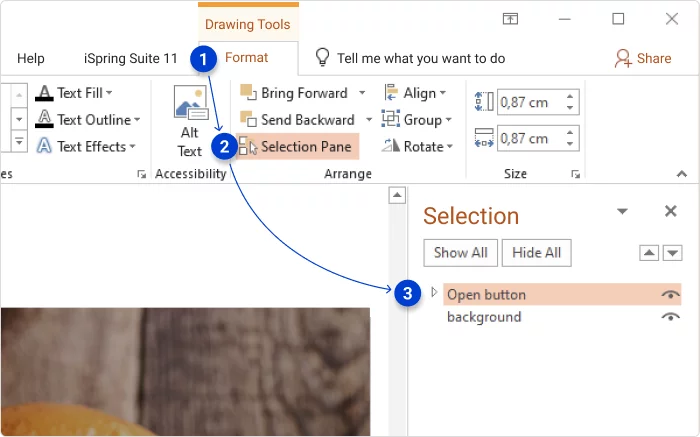
4. Create two new slide objects (and rename them): a text box and another button. This button will close the pop-up.
5. Open the Selection Pane and select the Open and Close buttons, along with the textbox . Simply hold down the Left Ctrl key and click each of the needed items:
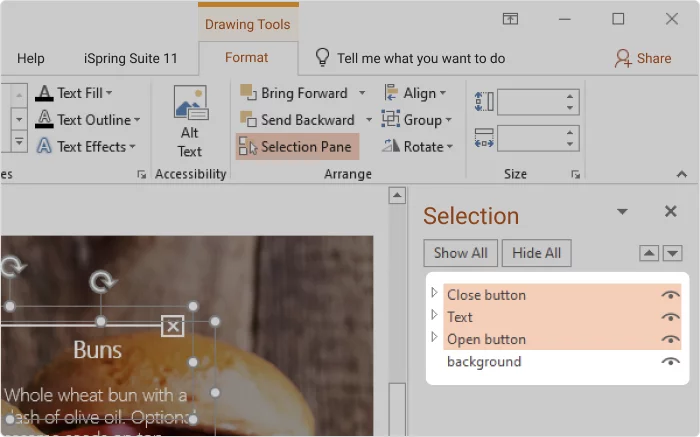
Now go to Animations → Add Animation → Entrance: Fade and then Add Animation → Exit: Fade .
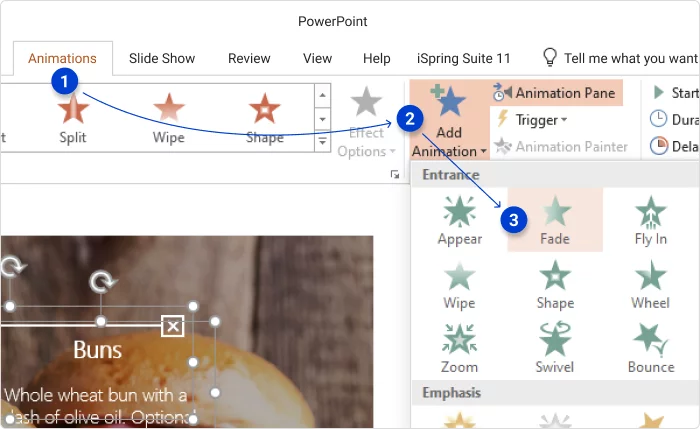
7. To see the entire list of animations on this slide, click on Animation Pane . Here’s how it should look:
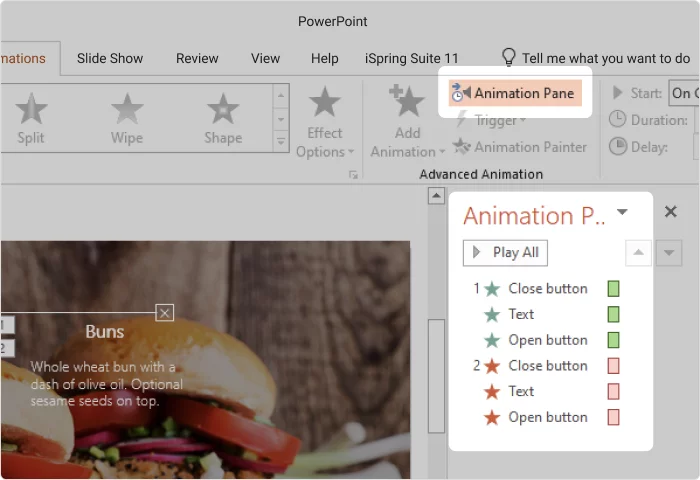
8. Now it’s time to set up triggers. Select the Entrance animations for the Close button and the textbox, then click on Trigger → On Click of and select the Open button shape. What this will do: when the Open button is clicked, the textbox and the Close button will appear.
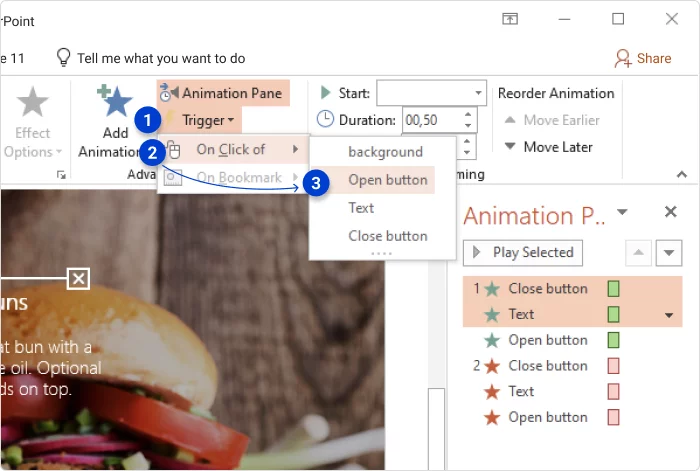
9. Now repeat the previous step but trigger the exit animations of the same objects by clicking on Close button . Once this has been done, you should see the following in the Animation Pane :
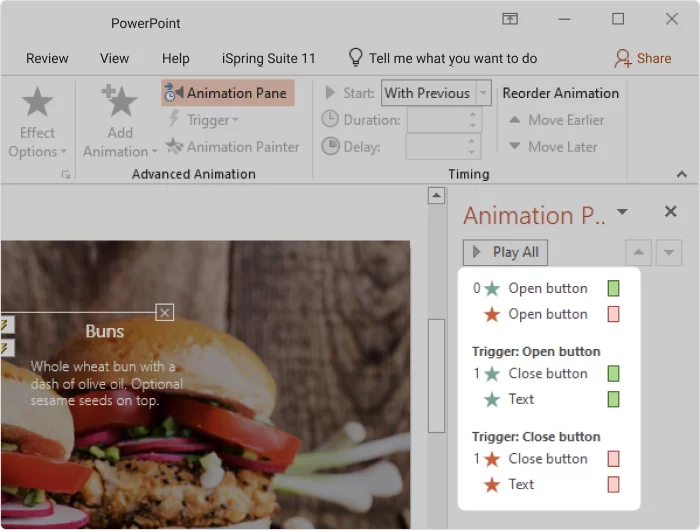
10. There’s one minor thing left to do: when you click the Open button, it should disappear, and when you hit the Close button, it should appear again. How do you make this happen? Simply move the Open button animations under corresponding triggers like this:
And that’s it, your interaction is ready. If you want to enhance the pop-up with visuals, like an image or another textbox, follow the same process and add their animations to the existing triggers.
Idea #2: Single-slide interaction with pop-ups
This second idea expands on the previous one: you can add several slide buttons that will activate pop-ups on the screen. Here’s what it looks like:
To design this type of interaction, you’ll need to create the interaction from the previous idea (or build a new one by following our guide) and then follow the steps below:
1. Create a set of objects for the second pop-up. If you need the same buttons, simply select an object you created earlier, then hold down Left Ctrl and drag it to a different position on the slide – and you’ll get an identical copy. You can also repeat this step with other objects.
2. Then, open Selection Pane and rename the new objects.
3. Now, animate the second pop-up. Press and hold Left Ctrl , then select objects in Selection Pane and add two sets of Fade animations:
4. Trigger the new animations using the same logic from the previous idea. Once finished, Animation Pane should look like this:
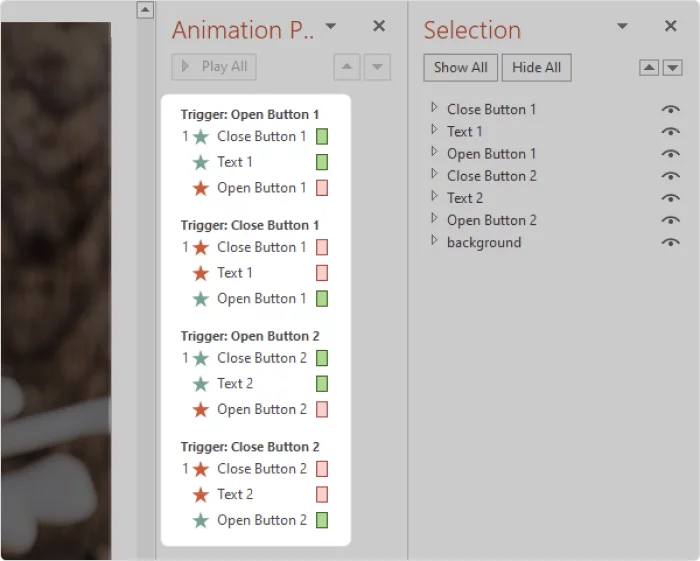
5. Your interaction is almost ready. All you still need to do is fix this issue:
As you can see, two pop-ups can now be opened at the same time and it doesn’t look good. To fix this, you need to set your animations so that when you click on “Open button 1,” the second pop-up button disappears, and vice versa. And make them appear again when either of the “Close buttons” is clicked. Here’s what your animation pane should look like:
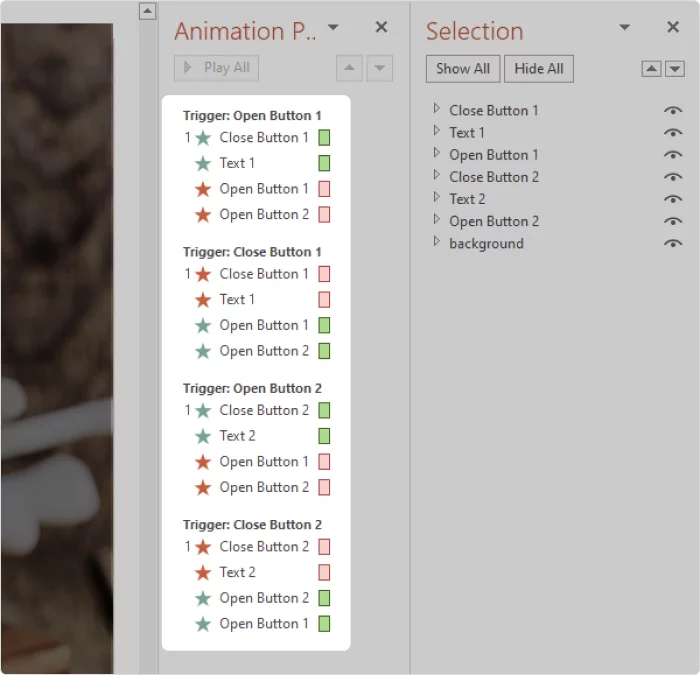
Now, your interaction should work like this:
And that’s it, your interaction with several pop-up menus is ready!
Idea #3: A quiz with branching scenarios
Another way to make your slides interactive is to add a quiz with clickable answer options. You can also make the test progress differently for each student, depending on the option they select: if the answer is correct, they proceed to the next question; if not, they go to the info slide to dive deeper into the topic. Or you can make it so that a learner receives feedback after each answered question.
Below, you’ll learn the basics of building quizzes and branching scenarios in PowerPoint, which you can further use for creating all sorts of tests – the essentials are the same.
1. Create the title page of the quiz. Add a background image, then type the title of your quiz and its description.
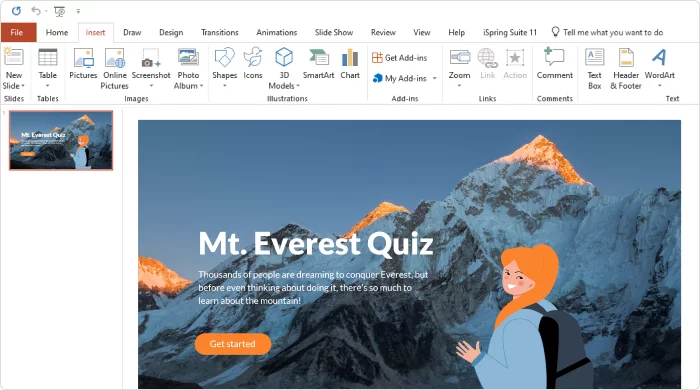
2. Move on to the next slide to add a question and answer options. For the answer options, you can simply use text blocks ( Insert → Text Box ) or shapes ( Insert → Shapes ). You can also add an image if you wish.
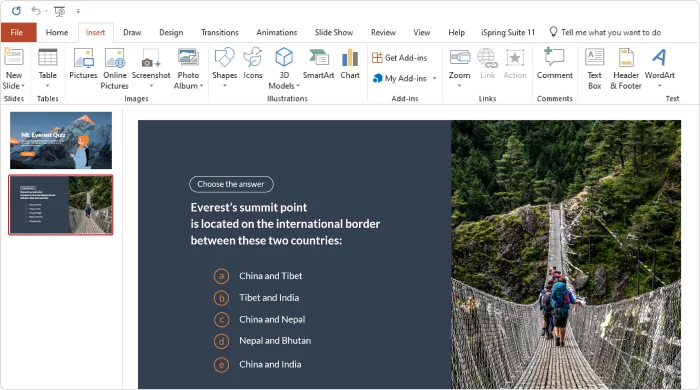
Add other question and answer slides for your test in the same way.
3. Create the correct answer slide after your first question. Add a congratulatory message, such as: “Well done!” or “That’s correct!” or “Correct!” Below the message, add a button that will take the learner to the next question.
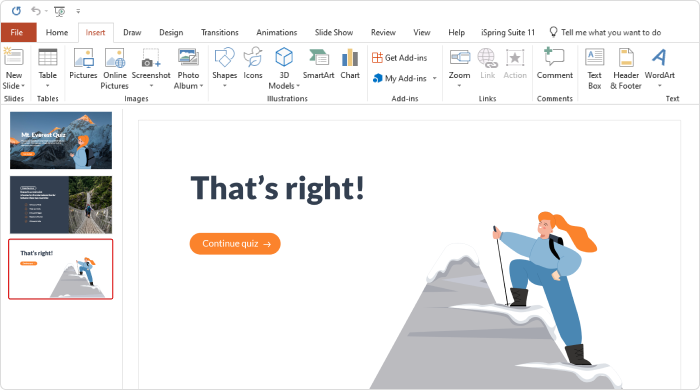
4. Create the incorrect answer slide. Repeat the same process as in the previous step but add a different text (and an image, if you use them).
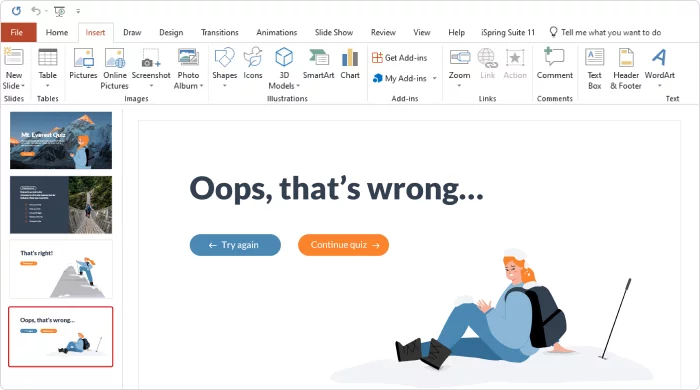
If you want to make knowledge checks even more insightful for learners, you can provide them with feedback on each incorrect answer.
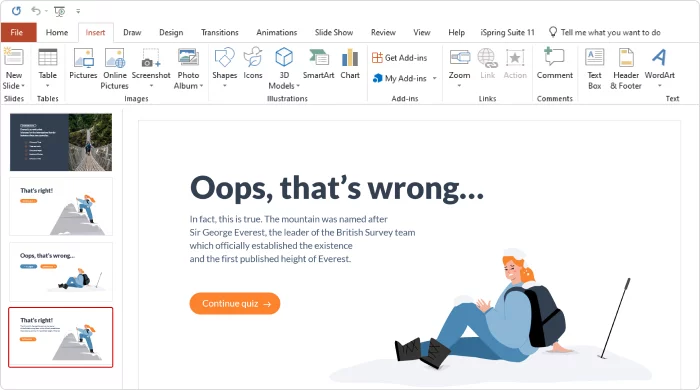
Add correct and incorrect answer slides after each question slide.
5. Set navigation for your quiz. Link the correct and incorrect answer options to the relevant feedback slides. Click on the answer text box, then go to the Insert tab and select Hyperlink . In the opened window, select Place in This Document and select the necessary slide.
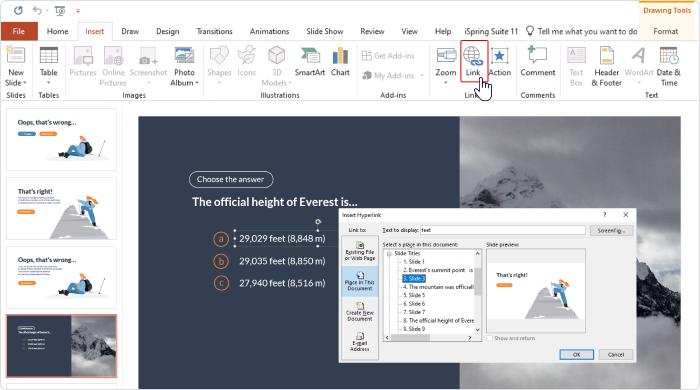
Then add a hyperlink to the button on the feedback slides. You’ll need to do the same for each slide because feedback slides should lead to a new question every time.
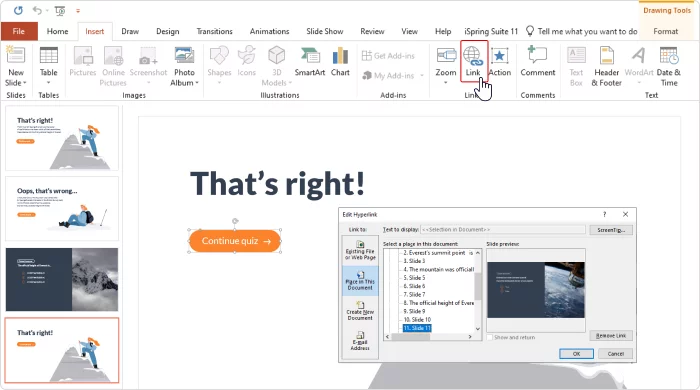
Once you’ve finished setting up navigation, your quiz is ready. If you want to learn more about this topic, read our article on how to make a quiz in PowerPoint .
PowerPoint isn’t designed for creating interactive slides. Yes, it’s possible to do this, but it requires a great deal of time and effort. So if you’re planning to develop such educational content regularly, consider using one of the 23 best PowerPoint add-ins . Some of them, like iSpring Suite , are built for this sort of task and empower you to create better content in less time.
iSpring Suite works as a PowerPoint add-in and provides you with templates and smart functions for designing advanced learning content quickly and easily. You can design interactions, quizzes, educational simulations, and many other content types. Then, you can upload them to your learning management system (LMS) or your online storage (iSpring Cloud) and share them with your learners.
Let’s see how to make your slides interactive using iSpring Suite. Download a 14-day free iSpring Suite trial and follow the steps below to put theory into practice.
Interactions
Open the iSpring Suite tab and go to Interactions. There are 14 interaction templates, such as an FAQ, a timeline, and a diagram. Select one of them, fill it with texts and multimedia, and that’s it – your interaction is ready!
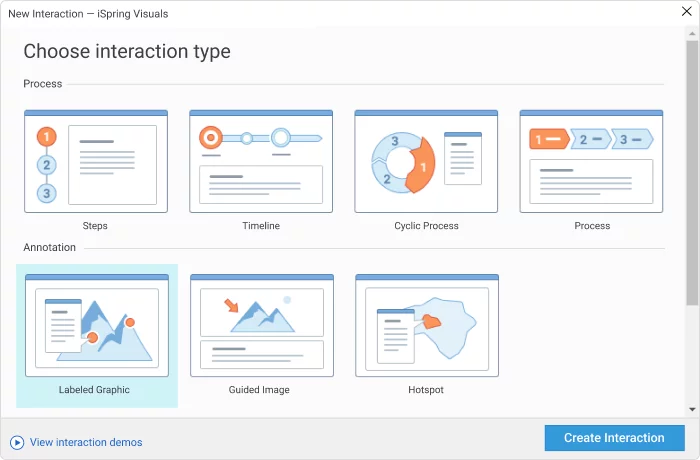
Watch this video to see the interaction development process from A-Z.
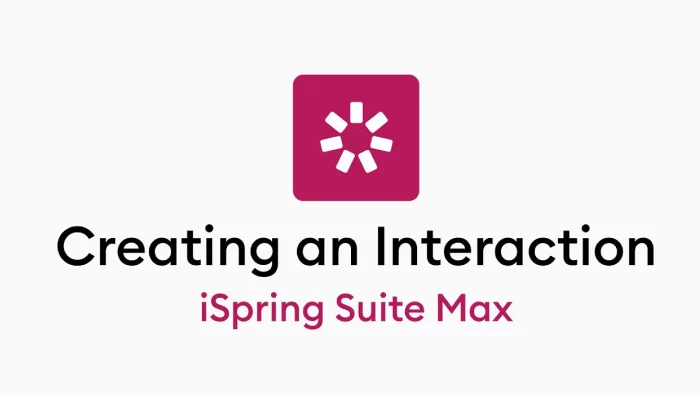
And here’s an example of an interaction created in iSpring Suite. It took us only 2 minutes to design it, while a similar interaction in PowerPoint took us at least an hour to create because we had to set up all of the triggers, animations, etc.
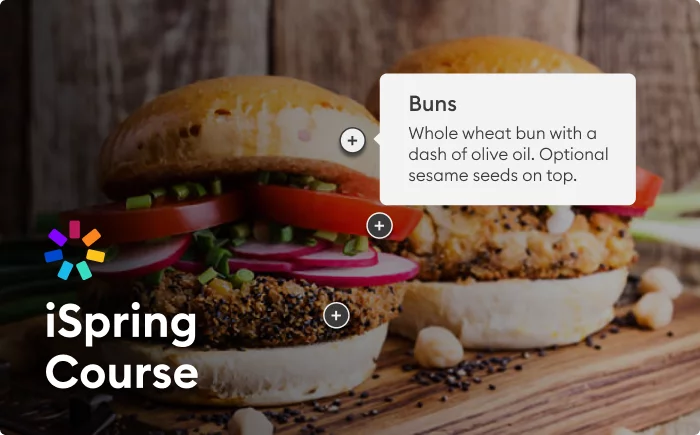
Just as with interactions, iSpring Suite has 14 ready-made question templates that you only need to fill with text and multimedia.
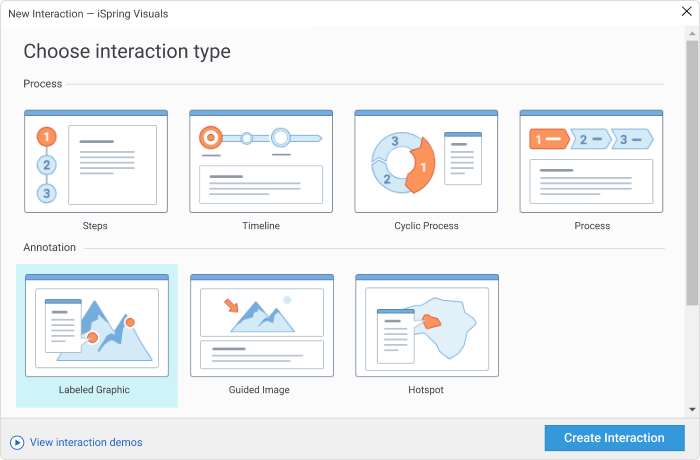
Here’s how. Open iSpring Suite, then go to Quizzes and click on Graded Quiz . Then, select a question type and fill it with information. If you wish, you can also add advanced settings, like time limits, the number of attempts allowed, and others.
See the entire routine in our tutorial video:

There’s no need to add separate feedback slides because feedback is already built into each question slide. You can customize it and add reinforcement information.
By the way, even if you don’t have an LMS, you can still share the test with your learners and track their progress – iSpring Suite has a special online storage space for that and the tool will email you the quiz results of your learners.
Here’s an example of a quiz created with iSpring Suite:

Role-play simulations
Role-plays scenarios or educational simulations are one of the most engaging educational activities in online learning. While most interactive tools require programming to create this content type, iSpring Suite enables you to create educational sims easily – even if you have no IT background.
Simply go to Role-Play and click on New Role-Play . Select New Scene . Pick a character and a background image from the library of ready-made content. Add texts. Then repeat the process with other scenes, connect them by dragging an arrow from one scene to another, and that’s it! Your sim is ready.
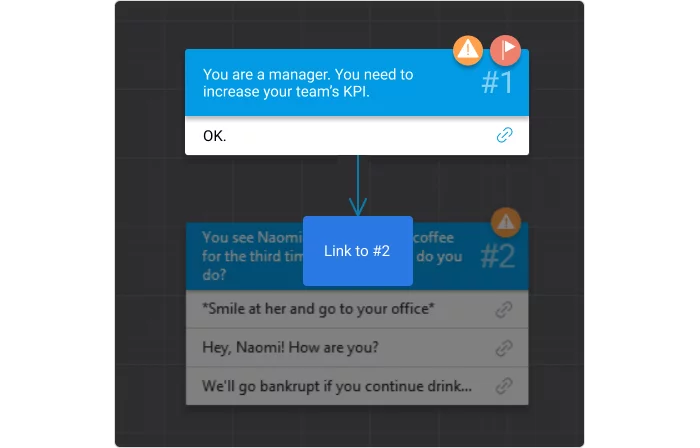
If you want to dive deeper into this topic, read our in-depth article on role-plays , their types with examples, and a guide and tips on creating them. It’s written by Clark Aldrich, the world’s most experienced designer of educational simulations.
And here’s an example of a role-play that Clark Aldrich created with iSpring Suite:

Now, let’s recap some highlights from this article. Here are the key takeaways.
Can you make a PowerPoint presentation interactive?
Yes, you can add interactive elements to your PPT presentation either by using PowerPoint alone or with additional tools, like iSpring Suite.
What are the interactive features of PowerPoint?
PowerPoint lets you create triggers and animations that make your presentation more interactive.
How do I make my PowerPoint presentation more engaging?
Consider adding interactions, quizzes, triggers, and animations to your presentation to make it more dynamic, engaging, and participatory.
So, these are several ways you can create engaging presentations with PowerPoint only and with other tools (check out this list of the 12 best interactive presentation software tools ). If you want to save time and effort while creating much more engaging and interactive presentations, courses, and assessments, check out iSpring Suite .
Get started with iSpring Suite for free during a 14-day trial period.
Also read: How to Convert PowerPoint to MP4 Video on Windows & macOS
Fast course authoring toolkit
Create online courses and assessments in record time.

Content creator:
Helen Colman
She enjoys combining in-depth research with expert knowledge of the industry. If you have eLearning insights that you’d like to share, please get in touch .
You might also like this

Subscribe to our blog
Stay tuned to get our latest eLearning tips and tricks!
By clicking “Subscribe”, you agree to our Privacy Policy . All emails include an unsubscribe link, so that you can opt-out at any time.
We use cookies to give you the best possible experience on our website and also for analytics and marketing purposes. You can enable or disable optional cookies as desired. See our Cookie Policy for more details.
Manage your cookies
Essential cookies are always on. You can turn off other cookies if you wish.
Essential cookies
Analytics cookies
Social media cookies
How to Give an Interactive PowerPoint Presentation in 2023

Presenting online is tough, yes. You can’t really connect with your audience. You often don’t even know whether those mute faces listen to you at all.
That’s why it’s important to go the extra mile and make your presentation interactive.
But that’s easier said than done, right?
Being for 7 years in the game of interactive presenting, I’d like to share some of my tips on how to activate your audience , create meaningful interaction, and facilitate it during your talk.
Get inspired by these (or some of these) tips for delivering a truly interactive PowerPoint presentation.
- Play music or do some chit-chat while waiting
- Welcome people and properly introduce the topic
- Explain how people can interact with you
- Involve the audience from the very start
- Re-engage your audience every 5-7 minutes
- Use polls to trigger a discussion
- Take advantage of Zoom’s interactive features
- Simplify your slides: One idea/visual per slide
- Play around with virtual backgrounds
- Use breakout sessions for peer-to-peer learning
- Turn tedious numbers into a quiz
- Invite a sidekick
- Run mid-way Q&A sessions
- Give your audience something tangible to leave with
- Run a short feedback survey at the end

1. Play music or do some chit-chat while waiting
Often it takes a couple of minutes before everybody jumps on a call. While you’re waiting for the rest of the crew to join, you can play some music in the background to set the mood and talk to the people who have already tuned in. “Has anyone discovered a good recipe lately?” or, “Did you do anything cool this weekend?”
You can share music during your Zoom call easily by clicking the ‘ Share computer sound ‘ checkbox.
As people are joining, you can also prompt them to turn on their cameras and unmute themselves for the time being, so that you can all see and talk to each other.
💡 Use icebreaker polls to strike up conversations while you’re waiting for others.
2. Welcome people and properly introduce the topic
Once everybody’s aboard, welcome your participants warmly, thank them for joining you, and tell everyone what you will be talking about today. You can even add an agenda slide to your presentation so you map out the whole session to your audience in advance. In the virtual environment, it’s even more important to navigate people through the talk.
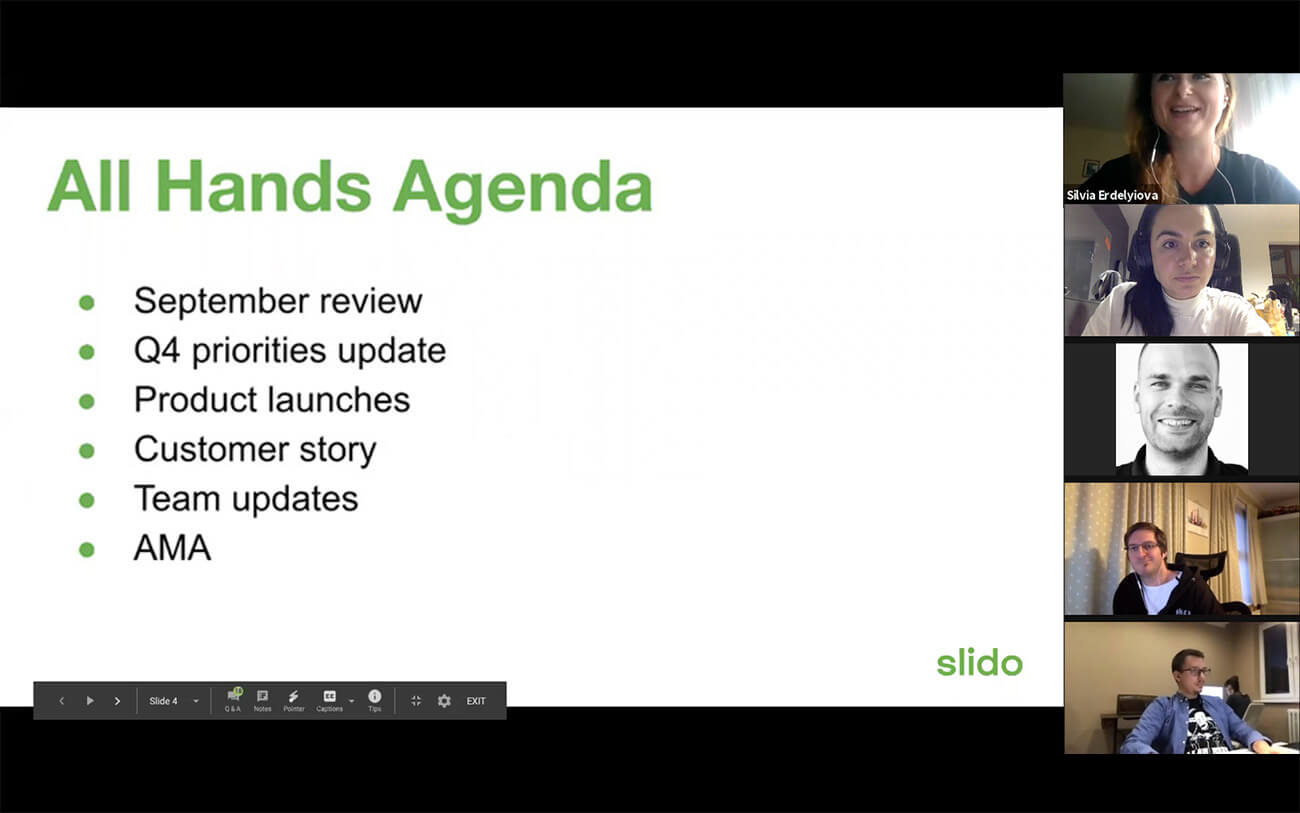
3. Explain how people can interact with you
Always check that everyone understands the technical side of things – otherwise, people may not know how to interact with you. Tell them what tools you’re going to use during the presentation and explain how they can use them.
It’s all about setting the right expectations: Do you want your participants to share comments via Zoom or Webex chat? Sure, tell them that. Explain how Webex or Zoom reactions work in case not everyone is familiar with them. If you expect verbal input from your participants, ask them to use the ‘Raise hand’ feature, so you can call on them if they want to contribute.
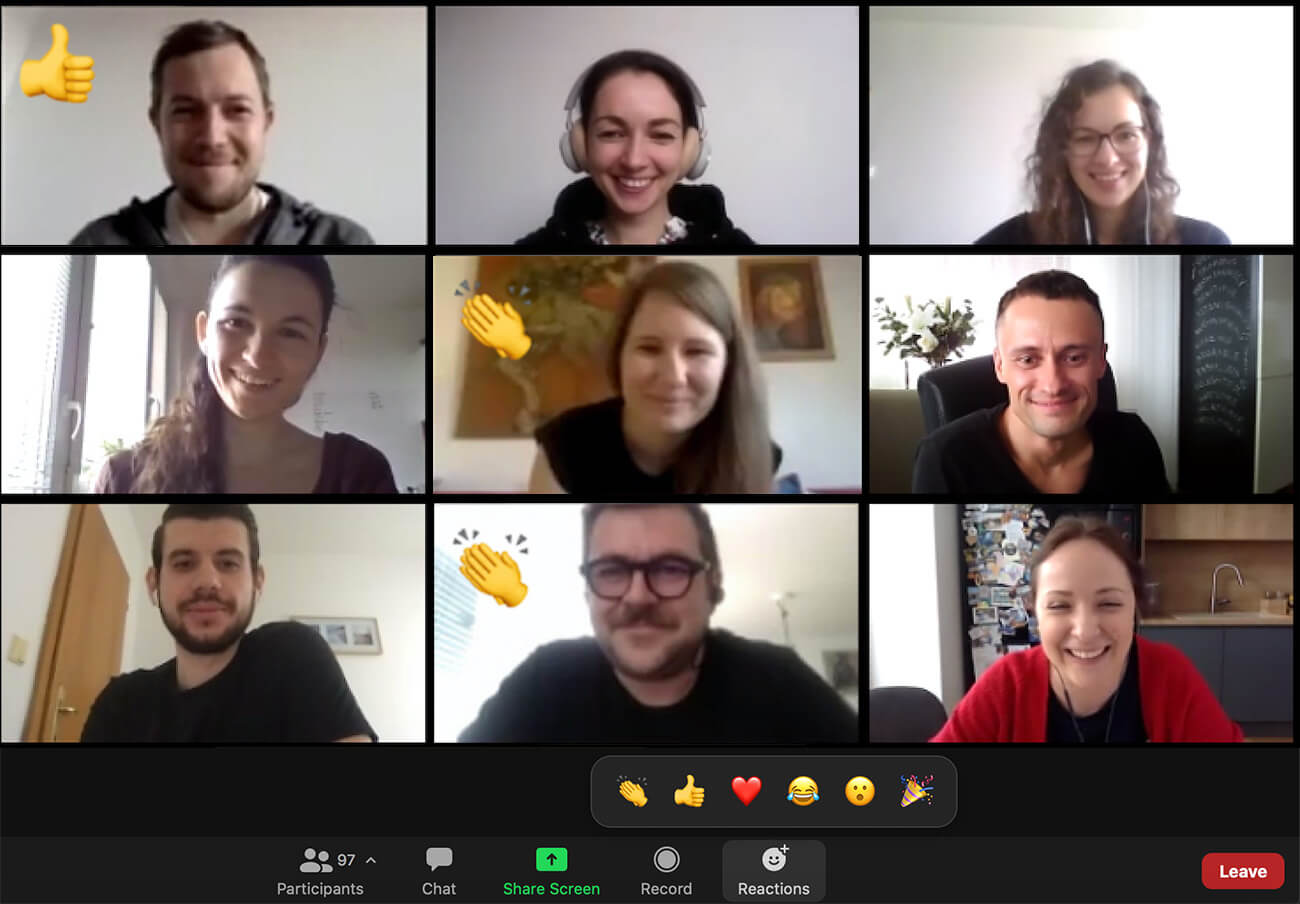
Are you going to use live polls throughout your presentation? Explain how people can vote in a poll or contribute with their ideas.
4. Involve the audience from the very start
Now that you’ve made it clear to your audience that you want and expect them to actively participate in the upcoming session, it’s time to give it a trial run.
Start a conversation with them right off the bat. For instance, I was recently a guest at an online fireside chat series called ‘Living Online’, run by our former Head of Education and a great moderator, Zuzana.
Before she dived into the topic, she collected insights from the audience. She ran a series of polls, asking people, “How much has the online world changed your life?” or, “What helps you find a balance between the real and the online world?”
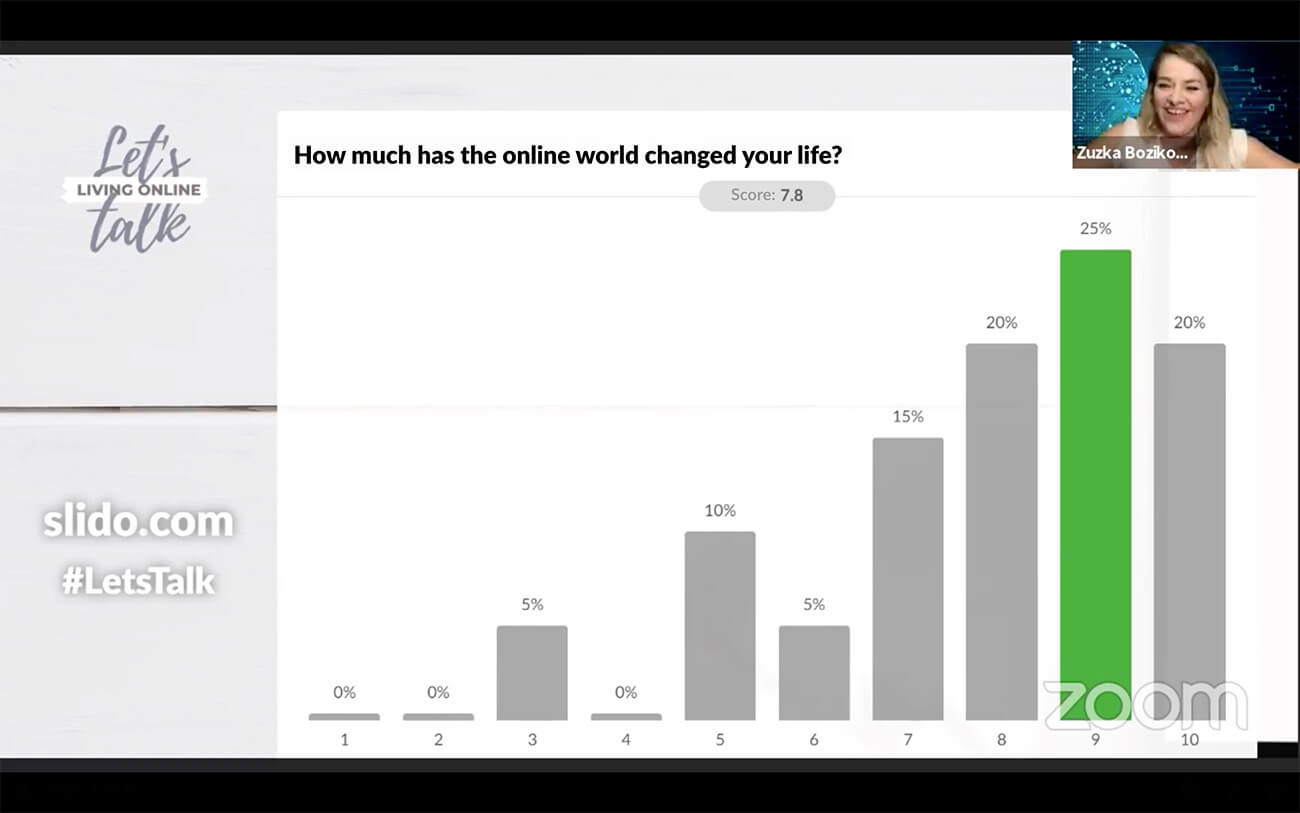
This way, she made the talk more about the audience, as opposed to just streaming information one way (while making sure people are familiar with the tech).
5. Re-engage your audience every 5-7 minutes
Keep the momentum and motivate your audience to “talk” to you throughout your presentation. Even if it is just in a non-verbal way.
We recommend using live polls or other forms of interaction every 5-7 minutes to pull people back in and involve them in a conversation.
Prepare several poll questions for your audience beforehand, and spread them out throughout your talk.
Is there a content-heavy part of your presentation that might be tough for your audience to process? At the end of it, use a rating poll to ask your audience how well they understood.

Are you about to propose an argument? Before you do, ask your audience what their viewpoint on the topic is first. (You can use live polls here too.)
Take inspiration from our Head of Internal Comms, Silvia, who – before giving a word to our CEO Peter who’d walk us through September highlights – began by using a word cloud to source highlights from the team.

6. Use polls to trigger a discussion
Live polls are invaluable for collecting real-time input from your audience. You can use that input effectively for starting a discussion.
For example, during our latest strategy meeting with our Brand team, I really needed to know whether the strategy points I presented to my team made sense, and I wanted to build up a discussion around them.
After each of the three presented areas, I ran a rating poll: “On a scale of 1-6, how important is this area in order to achieve our goals?”
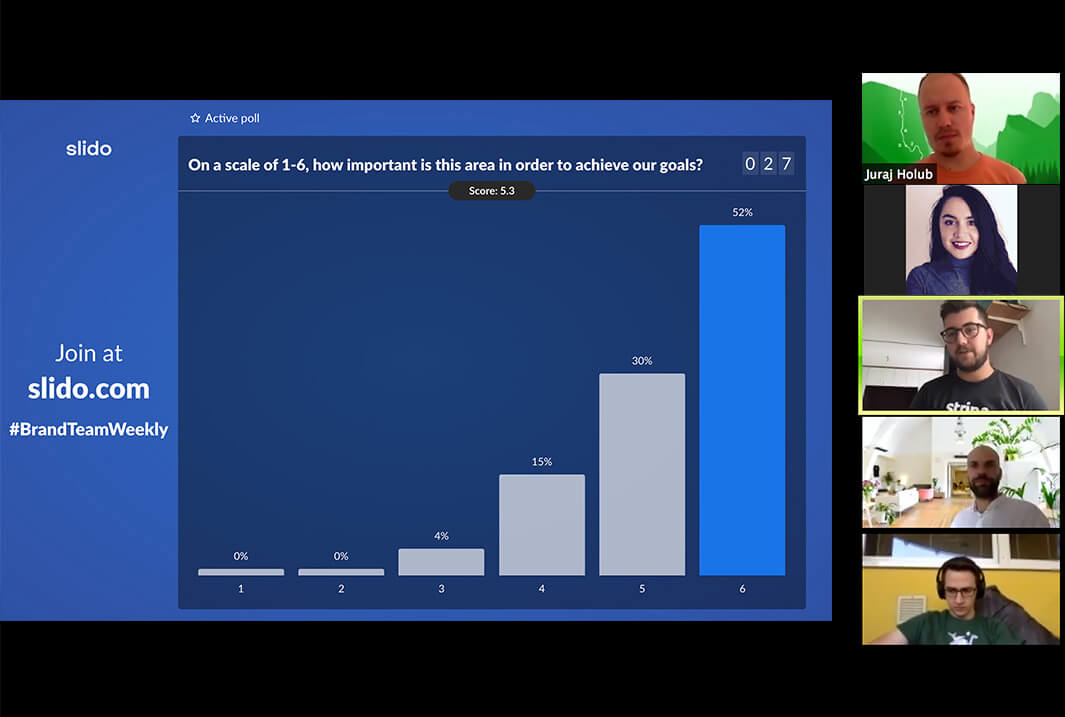
When votes came in, I commented on the results and whenever there were votes lower than 6, I asked: “Okay, who put 5/4? Can you please share your thoughts with us?”
This really changed the game for me, because I collected some invaluable insights from my colleagues that would otherwise have remained uncovered. Very often, people don’t share until you nudge them a little.
Read also: 7 Interactive Poll Ideas for Your PowerPoint Presentation
7. Take advantage of interactive features
Encourage your participants to ‘Raise hand’, use emoji reactions, or chat. Your meeting participants are probably not going to use them heavily unless you encourage them to do so.
I often use emoji reactions for fast feedback: I ask people to press thumbs up as an indication that they understand or agree, or to express that they like something with a clapping emoji or the heart symbol.

8. Simplify your slides: One idea/visual per slide
Make sure your slides are visually appealing. When listening to someone speak online, the last thing you want is to read huge bodies of text on slides. So don’t copy-paste the whole script of your speech. Use just one idea, one sentence, one topic, or one number per slide.

Where appropriate, support what you’re saying with an image, a graph, a gif, or even a meme. Do you want to show a video during your presentation? Make sure it’s really short because a video, no matter how entertaining, is yet another piece of content your audience consumes passively.
9. Play around with virtual backgrounds
Using a virtual background when presenting online can save the day if you need to quickly hide a messy kitchen or any trespassing relatives.
But, there’s more to it. You can tie it to the topic of your presentation and thus strengthen the message you’re trying to convey. For example, ever since our CEO Peter used climbing El Capitan as a metaphor for our company strategy, he uses an El Cap photo as his virtual background as a reminder for all of us that we still have a mountain to climb.

Need another great use of a virtual background? Pick a funny picture and use it as an icebreaker. For example, in several meetings, I put up a picture of a naked man chasing a wild boar, and believe me, there’s no better icebreaker !

People usually laugh and ask me why I picked this very image – it’s priceless to start a meeting with a smile on people’s faces!
Read also: 18 Best Virtual Icebreakers For Your Zoom Meetings
10. Use breakout sessions for peer-to-peer learning
This tactic is magic, especially with longer presentation types such as during all-company meetings, workshops, or training.
Propose a discussion topic or a challenge. Give your audience 1-2 minutes to think about it, before splitting them into smaller groups so that they can share their thoughts together and brainstorm solutions.
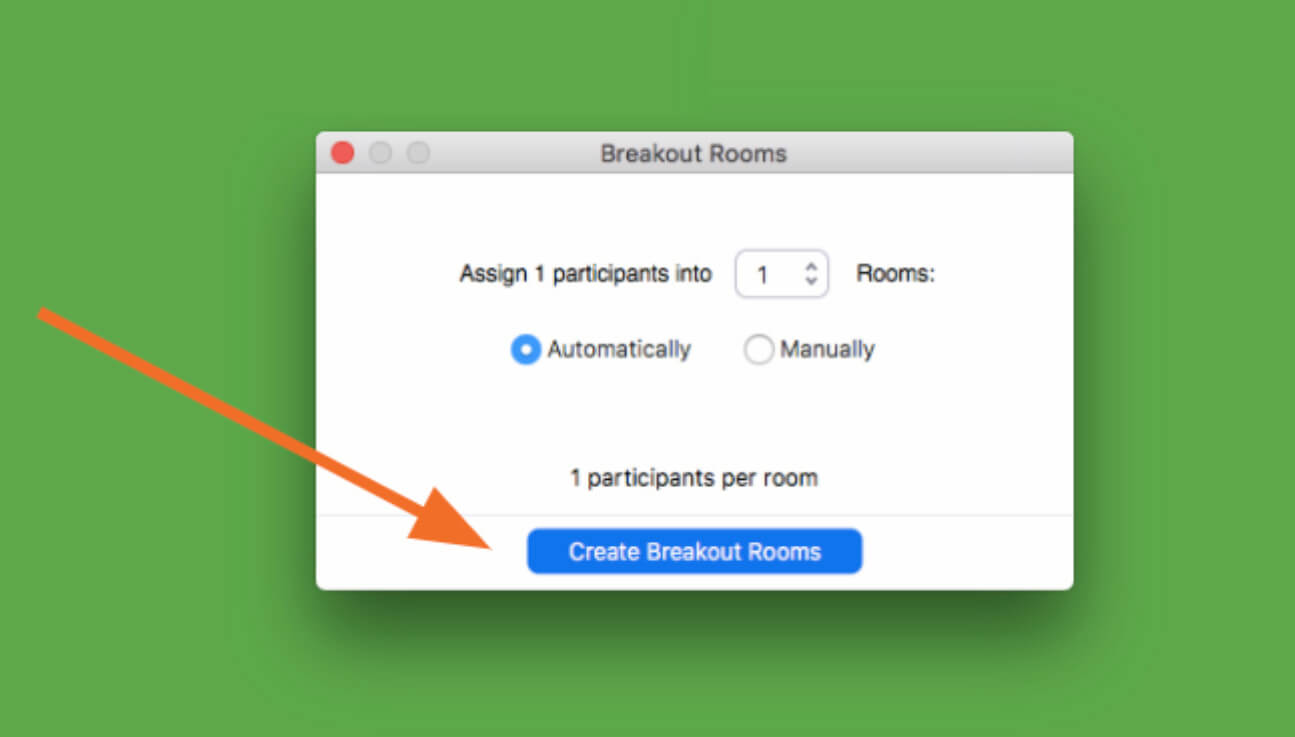
This is a great interactive exercise that helps you break the monotonous flow of one-way content broadcast and allow for some peer-to-peer learning.
You can also collect the learnings of your audience to include them in the presentation. For example, you can run an open text poll where you collect everybody’s key learnings and then display them on the screen. Let’s say you have asked your audience to discuss your company priorities. Try a word cloud such as: “Submit which priorities you discussed in your group.”
11. Turn tedious numbers into a quiz
Presenting company updates or business results can get quite tedious and your audience may easily start zoning out.
Turn it around and present your numbers in a form of a quiz .
For instance, before you reveal the number, say something like: “Before we look at the numbers, why don’t you guys have a guess at how well we did?” Then run a poll with multiple options and wait for your participants to cast their votes.
You can use this technique on multiple occasions. Our CEO, Peter, usually does this at our end-of-year all-hands meetings when he presents our business results such as revenue, sales, or a number of Slido events.
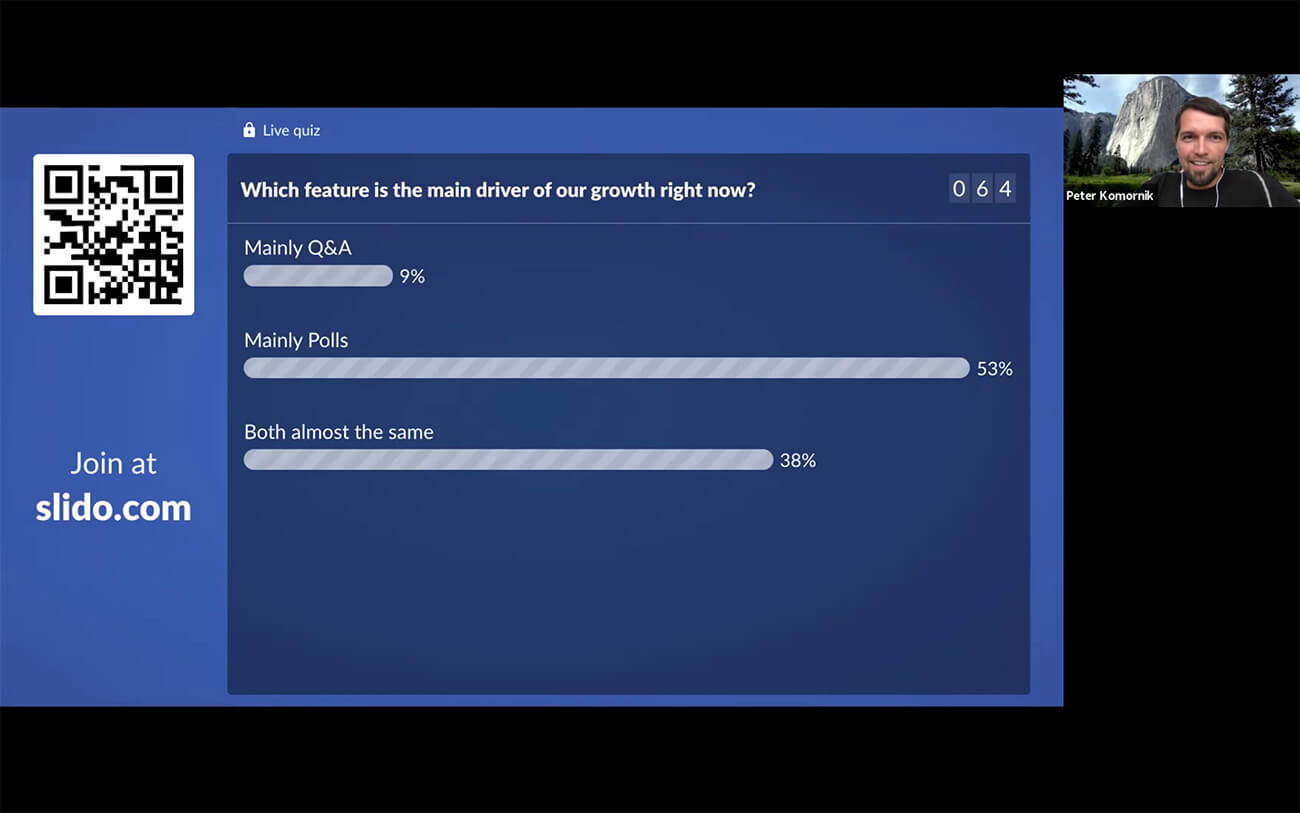
12. Invite a sidekick
Virtual presenters are superheroes that need to juggle multiple tools. And every Batman needs Robin. Consider inviting another speaker to deliver the presentation with you.
It will freshen up your talk and break the stereotype of only one speaker talking. On top of that, she/he can also help you with technicalities such as keeping an eye on the chat or troubleshooting any technical issues.
You can take turns in presenting the content or even give your presentation in the form of a conversation between the two of you. This way, it’ll be even easier for you to involve your audience in the talk, as they’ll be joining what already feels like an ongoing discussion.

Having a sidekick is invaluable if you’re running a Q&A round at the end of your presentation – they can help you manage questions from the audience.
13. Run mid-way Q&A sessions
Always make sure to leave space for Q&A – answering questions from the audience is one of the most important engagement points. Your participants will have a chance to dive deeper into the topic of your talk, and eventually, learn much more from your presentation.
Don’t wait until the end, but review the questions as they come in and take the most relevant ones continuously throughout your presentation (e.g. after each content block). If there are any outstanding questions, address them in the Q&A round at the end.
For example, during our recent product event , our Project Managers, Juraj Pal, Martin Srna, and Mario Ceselka, ran several Q&A rounds after each product announcement that they made. (Almost 350 questions came in! This is why it’s priceless to have a sidekick.)
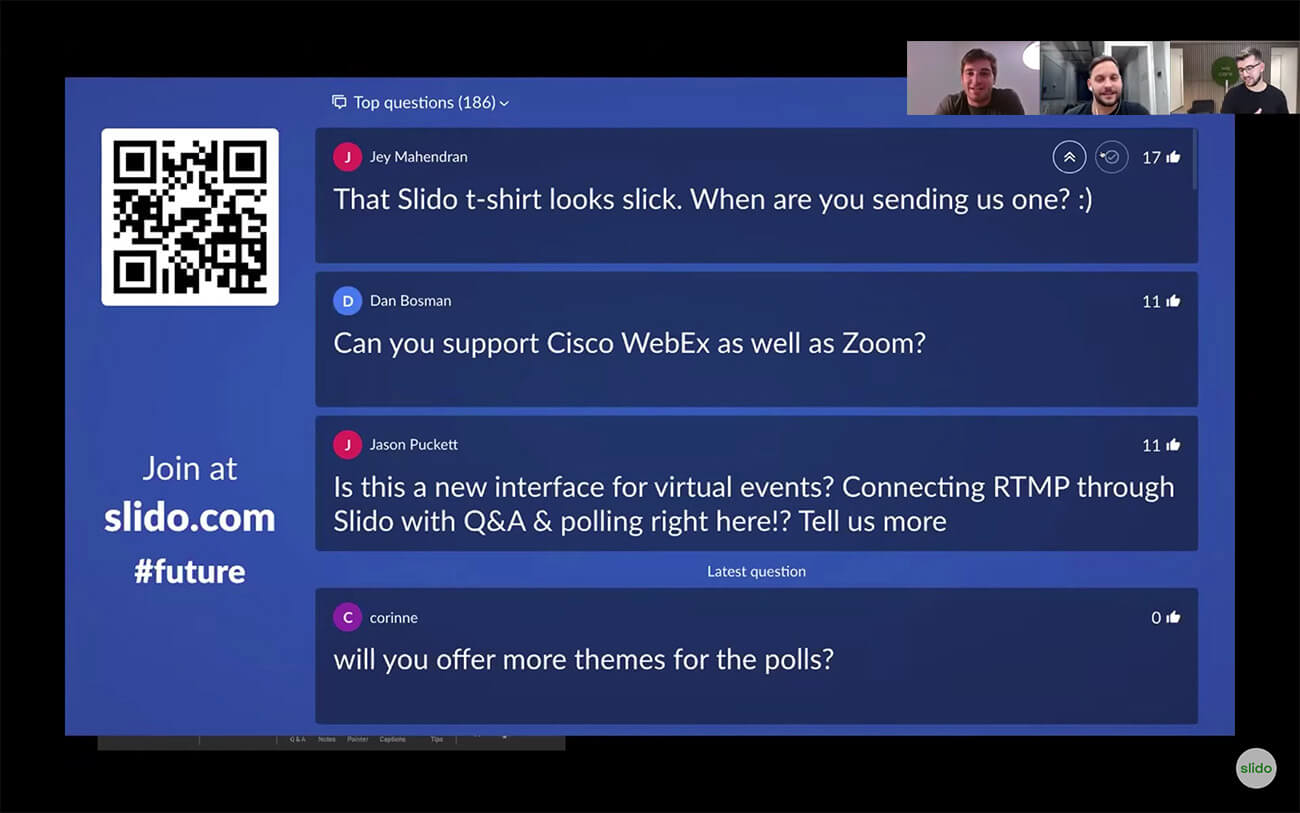
They also encouraged people to use upvotes, so the most popular questions can jump to the top and be answered with priority.
14. Give your audience something tangible to leave with
As you move towards the end of your talk, it’s good practice to reiterate the main message of your presentation to give your participants one concrete takeaway to remember.
You can make the ending interactive as well: Ask your audience to think about what they’ve just heard, then run a poll asking your audience: “What are you taking away from this presentation?” or, “What one thing resonated with you the most during this presentation?”
15. Run a short feedback survey at the end
Don’t forget to ask your audience for feedback. We’re always ready to rate our Uber drives or meal deliveries in order to help improve the experience. Why should presentations be any different?
Feedback is the best way for you to learn and find out what you can do better next time. Combine classic star rating with an open text poll so your participants can write more elaborate comments as well.
Two to three questions will suffice – you don’t want to wear your audience down with too long a survey (plus, you’ll boost the response rate!). Here’s an example that you can use:
- How would you rate today’s presentation? (Rating)
- What did you like most about this presentation? (Open text)
- Is there anything that could be improved? (Open text)
Over to you
Actively involving your audience in your content is key if you want to make your online presentation more interactive and engaging.
Using polls, quizzes, and collecting questions from your audience is one of the easiest ways to create more interaction during your talk.
With Slido for PowerPoint , you can add polls to your presentation and present seamlessly – all from one place. Watch this video to see how Slido for PowerPoint works. Click below to try it.
Add live polls directly to your PowerPoint presentation.
Get just a single email per month with our best articles..

Presentations
5 ways to use slido in google slides.
In this article, you’ll find examples of poll questions and quizzes that you can create with Slido and use in...

7 Interactive Poll Ideas for Your Next PowerPoint Presentation
Looking for new ways to make your PowerPoint presentation more interactive? Try live polls. With polls, you can collect non-verbal...

How to Run More Interactive Training Sessions with Live Polls (+25 Examples)
As a trainer, your ultimate goal is to help your participants develop skills and adopt new practices. But holding their...
How to Make an Interactive PowerPoint in 3 Easy Steps

Why Interactivity?
It's important for engagement. The more you allow your audience to participate and listen to them, the more they'll be engaged with your material and listen to you, right back.
How to go from PowerPoint to Interactive Slide Deck
To make any PowerPoint deck interactive, you can use Slides With Friends to give prompts and get responses from your audience, while still using the slides you created in PowerPoint. So whether you're looking to run a live poll of your conference audience, do an icebreaker before you start, build a wordcloud during your talk, or just get feedback from your audience members, this is the tool for you.
It's easy to do!
Step 1 - Get this interactive deck
To copy, you'll first need to create an account on Slides With Friends by clicking "Create free account". You can create the account and copy the deck for free, but the PowerPoint upload itself is a premium feature.
Once you've got an account, copy this sample deck: Interactive PowerPoint Deck Template . It's a template that you can add your own PowerPoint slides into. We'll walk you through how to customize it for your own slides!
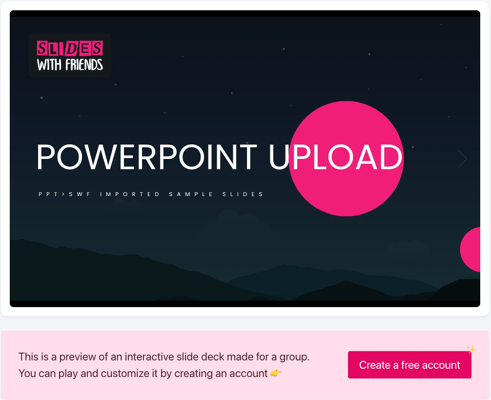
Step 2 - Add your PPT slides to your deck
Note, to upload your PowerPoint, you'll need an upgraded account first. Here's details on our pricing and how to upgrade to unlock this premium feature.
Complete your PowerPoint deck, save it, then add it to the deck you copied! Here's how:
- Head to your account and open the sample deck you copied
- Click "Import" to upload your .ppt, .pptx, or .pdf slide deck presentation.
- Select "replace" — this will remove the sample imported slides, and replace them with your own.
- Drag your file into the upload box. The fewer slides you have, the quicker it will be to upload.
Step 3 - Add interactions
Once you've got your PPT slides in your presentation, you can now add the interactive portions.
Each interaction is added like a new slide to your deck. So for instance, if you want to add a Poll question to a PPT slide, this would be a new slide that you would place directly after your static PowerPoint slide.
Add these interactions by opening the "+" button in the top menu, and selecting what type of interactive slide you want to add. Here are the options of all the interaction types you can add:
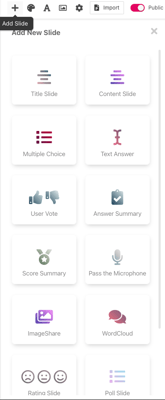
Multiple Choice Question: A slide that asks a question and supplies a set of answers that your players can choose between. You can show who guessed what, and the correct answer(s), optionally after each question. These slides are best for surveys, trivia questions, quizzes, polls, and anywhere else there are a fixed set of responses.
Text answer question: A slide that asks a question but doesn't give answer options to choose from, instead your audience types their response. The system will determine if a response is correct or incorrect by comparing it to the answer(s) you have input.
User Vote: An Apples to Apples or Cards Against Humanity style interaction. Give a prompt or ask a question, and players send in responses. Then they can vote for their favorite, from all the other player's responses.
Answer roundup: If you've hidden the correct answers from the any previous multiple choice or text answer questions, you can display them all in a row with this slide.
Score summary: Show the leaderboard! Display those with the highest scores so far. You can set how many players to show in a row.
Pass the mic: Display each participant's avatar, one at a time in a random order, to give them a chance to speak. You can set how many players you'd like to go through — from everyone in the game to just one person.
Picture share: Players can upload or take images with their phones. The slide will then show a however many images you selected that it display, in random order, one at a time. Think of it like photo show & tell.
Wordcloud: Players can send a word or short phrase, and it will pop up on your display screen. They can tap on words from others to make those words larger. The end effect is a cloud of words with the most popular words appearing larger.
Rating: Allow participants to select from a set of pre-determined rating options, from Likert scores, to agree / disagree, to Emoji faces.
Poll slide: Allow participants to select from up to 6 answer options that you've type in. Then display the responses in a graph, donut chart, or by player name.
Last thing — Try it out!
It's time to see how everything works!
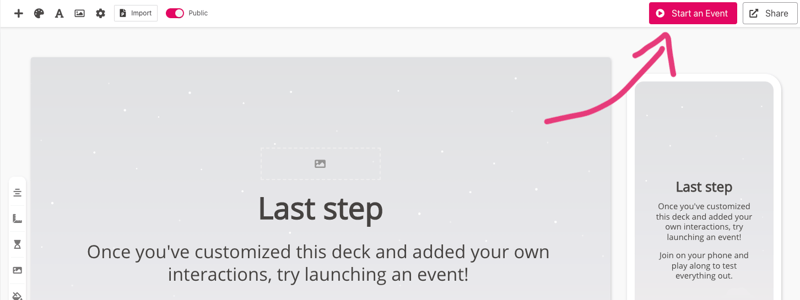
Start an event and join in yourself using your phone to scan the QR code. You'll be able to see how the event will look to your players, how your PPT slides look on the phone, and send responses to see how everything works.
Watch the video for an in-depth tutorial:
You can watch the video, or simply follow the steps below.
Subscribe for more articles like this
Try slides with friends for free.
The easiest way to host meetings your team will love
Engagement delivered to your inbox
We'll email you 1-2x per month with brand new, ready-to-run events and ideas. Subscribe to stay ahead of the curve and keep your lessons, meetings, and events fresh and engaging.
Interactive PowerPoint Presentation: Convert PPT to eLearning Module
by Quynh Anh | Dec 18, 2023 | eLearning
You might have visualized in your head how to make your presentation interactive . However, do you know step by step how to convert your existing PowerPoint presentation into an eLearning module? There is a must-have item you should not miss out on. It is a powerful eLearning authoring tool. Therefore, this post will guide you in detail how to add interactivity to your premade PowerPoint presentation using an all-in-one course creator, ActivePresenter.
Stage 1: Preparation
- Prepare PowerPoint Presentation
Designing the core content of your presentation in PowerPoint in advance will help save time a lot if you have been familiar with using Powerpoint. Or even if you want to create everything from the very beginning, you can still do that easily in ActivePresenter. No matter which way you choose, all materials will need to be well-prepared first:
- A scenario of the whole course/ presentation
- Text content for each slide
- Audio recording/ background music/ sound effects for each slide and object
- Images for illustration
- Videos/ screen recordings for illustration
- Intended animations/ transitions/ interactions
- Downloadable resources
Before coming to animated and interactive factors, make sure to complete all the content in the static state first. And, one tip at this step is avoiding lengthy texts . You should use mind-mapping techniques to make the overview of the presentation logically and consistently. Also, visual elements are especially necessary . To illustrate information, try using infographics, charts/ graphs, and videos/ images instead. Later on, integrating interactive elements to your presentation like quizzes, sliders, buttons, or mouse clicks will even increase the attractiveness of the slides.
- Import PowerPoint into ActivePresenter
After finishing preparing the PPT presentation, it’s time to use the second tool, ActivePresenter, to add interactive elements to your PowerPoint. Or, if your computer doesn’t have Microsoft PowerPoint installed, you can still import PowerPoint slides directly into ActivePresenter 9.
- On the Start Page , click Import PowerPoint > browse and select the PowerPoint file you want to import.
- In the workspace, click the ActivePresenter button (1) > Import PowerPoint (2) > select the PowerPoint file on your computer.
Read this full tutorial here for more information about how to import.
But, before importing your PPT presentation into ActivePresenter, don’t forget to check if your setting is Import PowerPoint animations to the main timeline or not. Your checking or unchecking this option will affect how you control the animations later in the output. Let’s continue reading to understand.
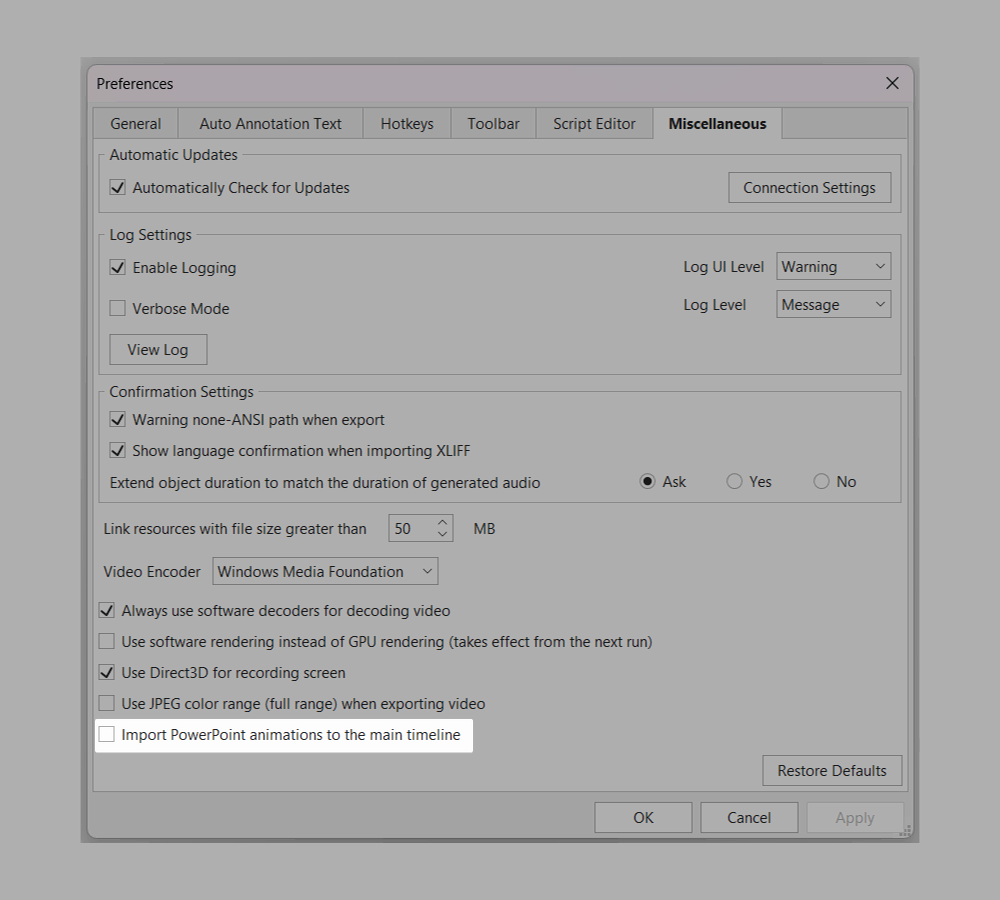
Stage 2: Conversion from PowerPoint to Interactive eLearning Module
- Differentiate Animations in Click Sequence Timeline and in Main Timeline
As mentioned above, checking or unchecking the Import PowerPoint animations to the main timeline will lead to 2 cases:
- Adjust Imported Slides’ Properties
When finishing importing the PowerPoint slides, ActivePresenter will launch a new project with the slides included. All similar factors like texts, shapes, graphs, videos, images, sound, and so on will be kept totally. Fonts, sizes, and colors of objects are consistent with those in PowerPoint as well. But before that, don’t forget to install the necessary fonts on your computer for ActivePresenter to access and display them correctly.
Each PowerPoint slide now becomes an ActivePresenter slide. And, you can use various functions and commands to edit the slide and its contents similarly to how you edit in PowerPoint and even more. For example, copying, cutting, or deleting slides/ objects, splitting and merging slides, changing slide transition effects, recording extra screen tutorials, or adjusting animations.
- Add Interaction Object or Interactive Quiz into the PowerPoint Presentation
If you feel too familiar with animations in PowerPoint and want to find something more interesting, ActivePresenter can perfectly solve that need. Not only does the software support all similar animations in PowerPoint, but it also allows you to create other types of interactive navigation between slides and objects.
Create Interaction Objects for Your Interactive PowerPoint Presentation
When you add these interaction objects to your slides, users can interact with these objects in the HTML5 output by
- answering questions,
- clicking on a button,
- dragging and dropping objects,
- selecting checkboxes/ radio buttons,
- or entering text into a text box.

The available interaction objects you can use in ActivePresenter are questions, mouse clicks, key strokes, text entries, drop areas, buttons, checkboxes, radio buttons, sliders, dropdowns, and animated timers. Details about each of these objects can be found in this overview tutorial .
Add Interactive Questions to Your Interactive PowerPoint Presentation
Besides interaction objects, what makes eLearning tools like ActivePresenter favorable among creators is its built-in presets. For example, in ActivePresenter, those presets are built-in question types. Users no longer need to self-design question layout or find ways to make them interactable. The 13 types of questions in ActivePresenter have been set up in advance with:
- ready-made 3 parts visually (question title, answer area, and submit button)
- built-in Score & Reporting and Events – Actions systems
- built-in feedback messages when learners answer questions correctly, incorrectly, or undone
You can take a look at the overview post of these 13 types of questions in ActivePresenter here .
- Trigger Events – Actions to Create Interactive PowerPoint Presentation
After building all the content visually, it’s time we came to setting up interactivity for the whole presentation or course. As you can see from the settings of interactive questions above, events and actions are important parts if you want to create highly interactive quizzes, courses, or games in any authoring tools, especially in ActivePresenter 9.

- An event is an activity that users do to interact with an object. For example, hovering the mouse over/out an object, or clicking on an object.
- When an event occurs, it triggers one or several actions. In the demo above, actions could be highlighting the image, showing the info text, or navigating to another slide.
Let’s read this tutorial to know in more detail how to work with events and actions to trigger interactivity in ActivePresenter.
Stage 3: Sharing & Publishing
Unlike normal PPT presentations, to view the outputs made in authoring tools, you will not view and share them directly. Instead, you will need to share on certain platforms or compress as a zip file to send it. This is because your outputs include interactive elements. To be able to interact with them, viewers will need to get access to the platforms where you upload the outputs. In ActivePresenter, there are 3 ways for users to export and distribute the outputs .
- Export to HTML5
If you choose this option to export your project, you will need a web server. This is because the output uses the HTML5 standard. And you will embed this output into a webpage. Once finished exporting and embedding it, users can view and interact with the content on the World Wide Web. However, this method does not allow tracking user interaction and results as using an LMS. For example, the game I embed below is the result of exporting to HTML5 and embedding it into this website:
You can take a look at more tutorials below:
Export Project to HTML5
Embed HTML5 Course into a Webpage
- Export to SCORM or xAPI to Upload to LMS
This is the recommended method for all eLearning creators. You will use a Learning Management System (LMS) in this case. This means that you will have to export your project to SCORM or xAPI package. It enables you to effectively manage, deliver, and track training courses. You can explore popular LMS options like Moodle Cloud, TalentLMS, and Scorm Cloud.
And, to know whether to choose Export to SCORM or Export to xAPI, you will need to define which formats your LMS supports the best. Let’s read the tutorials below to better understand.
Differentiate SCORM vs. xAPI
Export Project to SCORM
Export Project to xAPI Packages
- Compress as A Zip File and Share
The final option is to compress the project as a zip file and share it. In this way, you can share it via any sharing platforms like email, Google Drive, OneDrive, Zalo, and so on. However, this method also lacks the tracking capabilities of an LMS. It only supports viewers viewing and interacting with the content.
So, you will choose Export to HTML5 , then tick the Generate Zip option.

Final Thoughts
Turning a static PowerPoint presentation into an interactive course module has no longer been a challenge once you own an ActivePresenter license. Download the software and try all features with no limitation in trial time and functionality now. Millions of users have chosen ActivePresenter as a reliable companion in terms of interactive course editing and screen recording? What about you?

Table of Content
1: Preparation
2: Conversion from PowerPoint to Interactive eLearning Module
3: Sharing & Publishing
What’s it for?
Make interactive presentations
Create show-stopping presentations and clickable slide decks with Genially’s free online presentation builder. Leave boring behind and tell a story that’s interactive, animated, and beautifully engaging.

INTERACTIVE CONTENT
A presentation that works like a website
Engage your audience with interactive slides that they can click on and explore. Add music, video, hotspots, popup windows, quiz games and interactive data visualizations in a couple of clicks. No coding required!
NO-CODE ANIMATION
Make your slides pop with animation
Bring a touch of movie magic to the screen with incredible visual effects and animated page transitions. Add click-trigger and timed animations to make any topic easy to understand and captivating to watch.
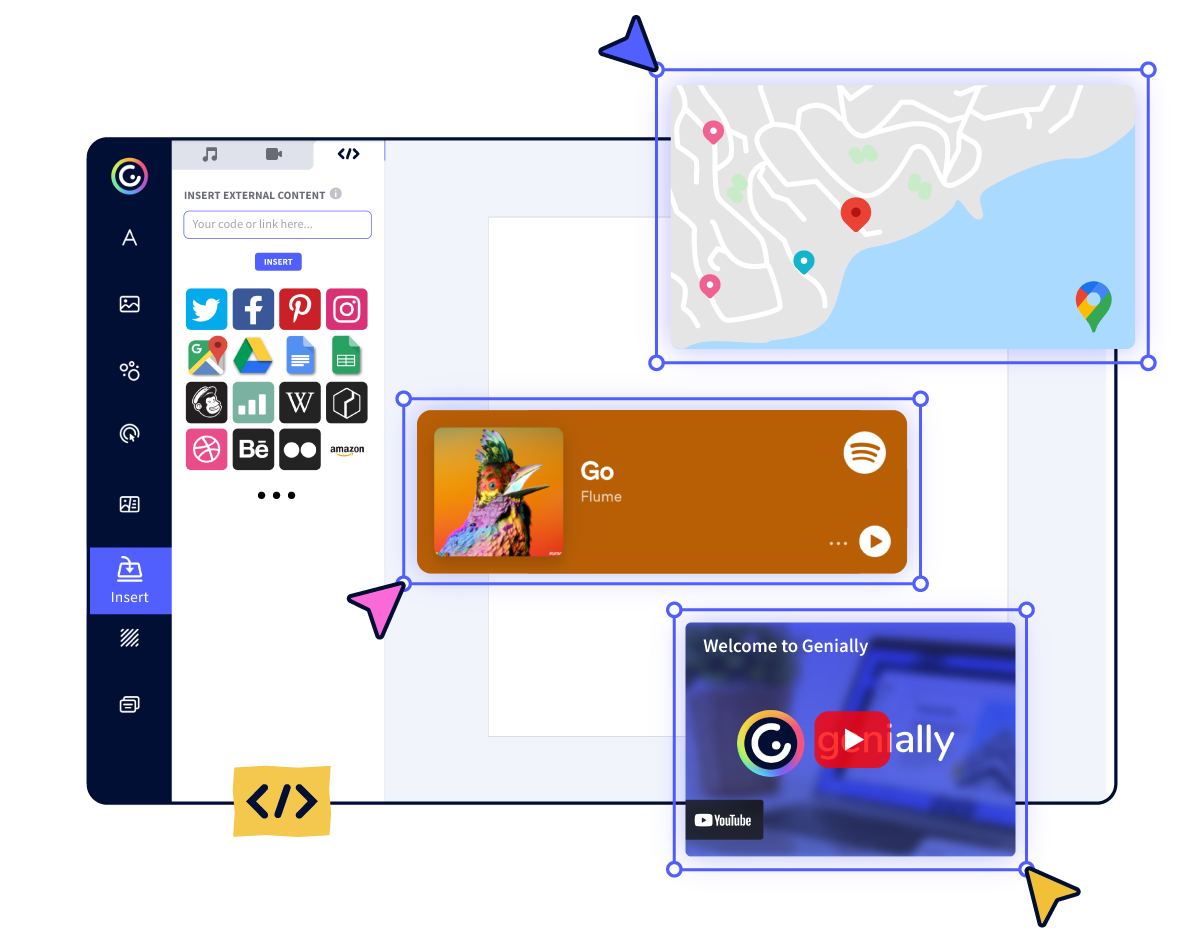
INTEGRATIONS
Live from the world wide web
Embed online content directly in your slides for a media-rich interactive experience. From YouTube and Spotify to Google Maps and Sheets, Genially works seamlessly with over 100 popular apps and websites.
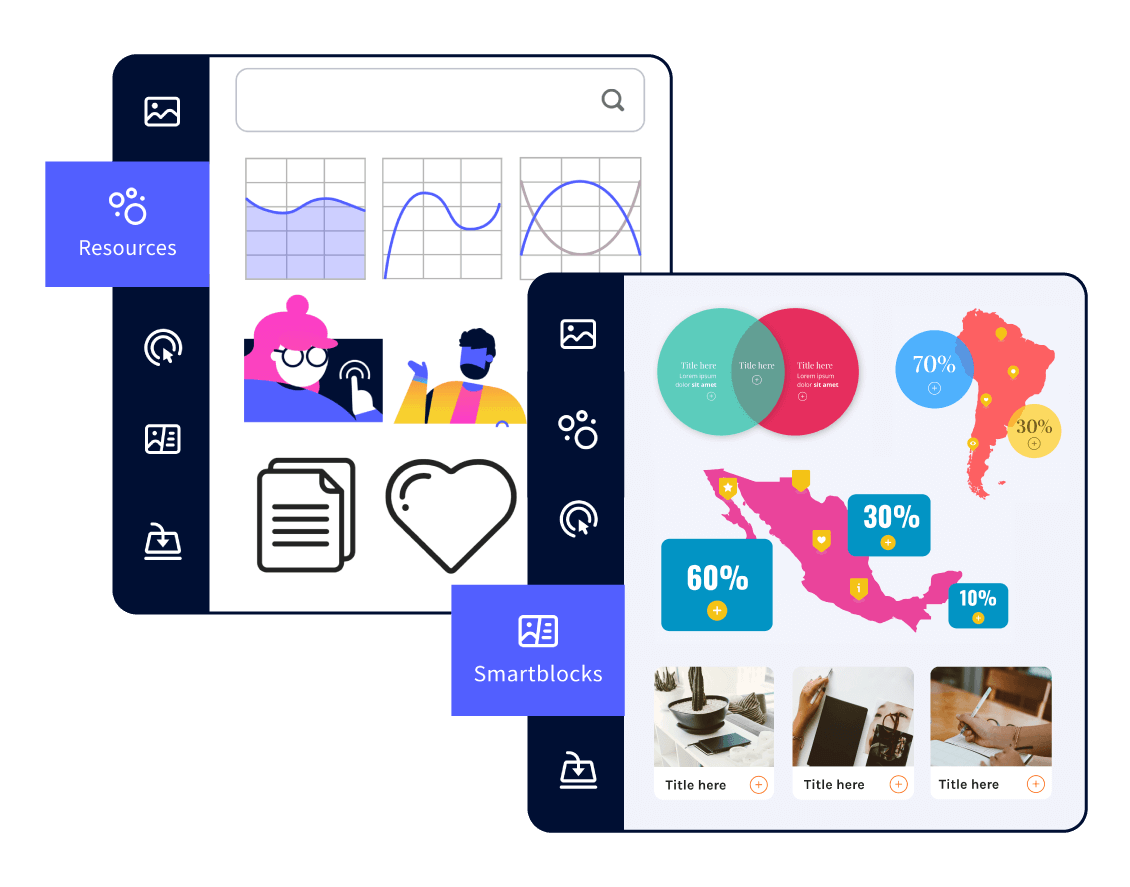
TEMPLATES & TOOLKIT
Genius design tools
With Genially, anyone can create a polished and professional presentation. Choose from over 2000 pre-built templates, or create your own design using the drag-and-drop resources, color palettes, icons, maps and vector graphics.

ONLINE PLATFORM
Safe and sound in the cloud
Because Genially is online, you can relax knowing that your slides are always up-to-date. There’s no risk of forgetting to save changes or accessing the wrong file. Log in from anywhere, collaborate with your team, and make edits in real time.
All-in-one interactive presentation maker
Real-time collaboration.
Co-edit slide decks with others in real time and organize all of your team projects in shared spaces.
Multi format
Present live, share the link, or download as an interactive PDF, MP4 video, JPG, HTML, or SCORM package.
Engagement Analytics
See how many people have viewed and clicked on your slides and keep tabs on learner progress with User Tracking.
Import from PPTX
Give your old decks a new lease of life by importing PowerPoint slides and transforming them with a little Genially magic.
Keep content on-brand with your logo, fonts, colors, brand assets, and team templates at your fingertips.
Quiz & Survey Builder
Use the Interactive Questions feature to add a fun quiz to your slides or gather feedback from your audience.
Beautiful templates
Make your next deck in a flash with Genially’s ready-to-use slides.

OKR Presentation
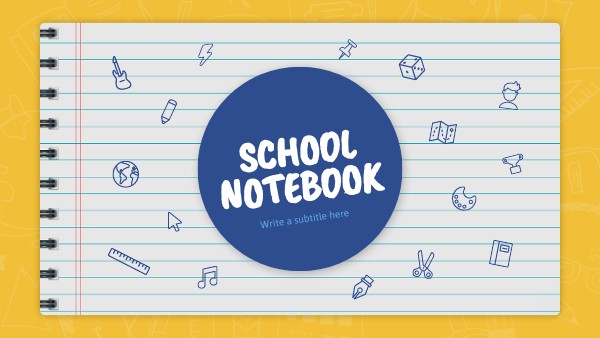
School Notebook Presentation

Animated Sketch Presentation

Minimal presentation
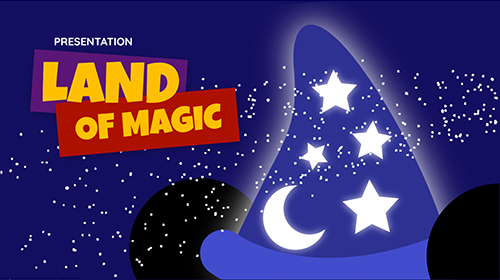
Land Of Magic Presentation

Onboarding presentation

Visual Presentation

Animated chalkboard presentation

Online Education Guide

Terrazzo presentation

Startup pitch

Historical presentation
THEMES FOR EVERYONE
Interactive presentation ideas
From classroom materials to business pitches, make an impact every day with Genially.

Education presentations

Pitch decks

Business presentations

Thesis defense
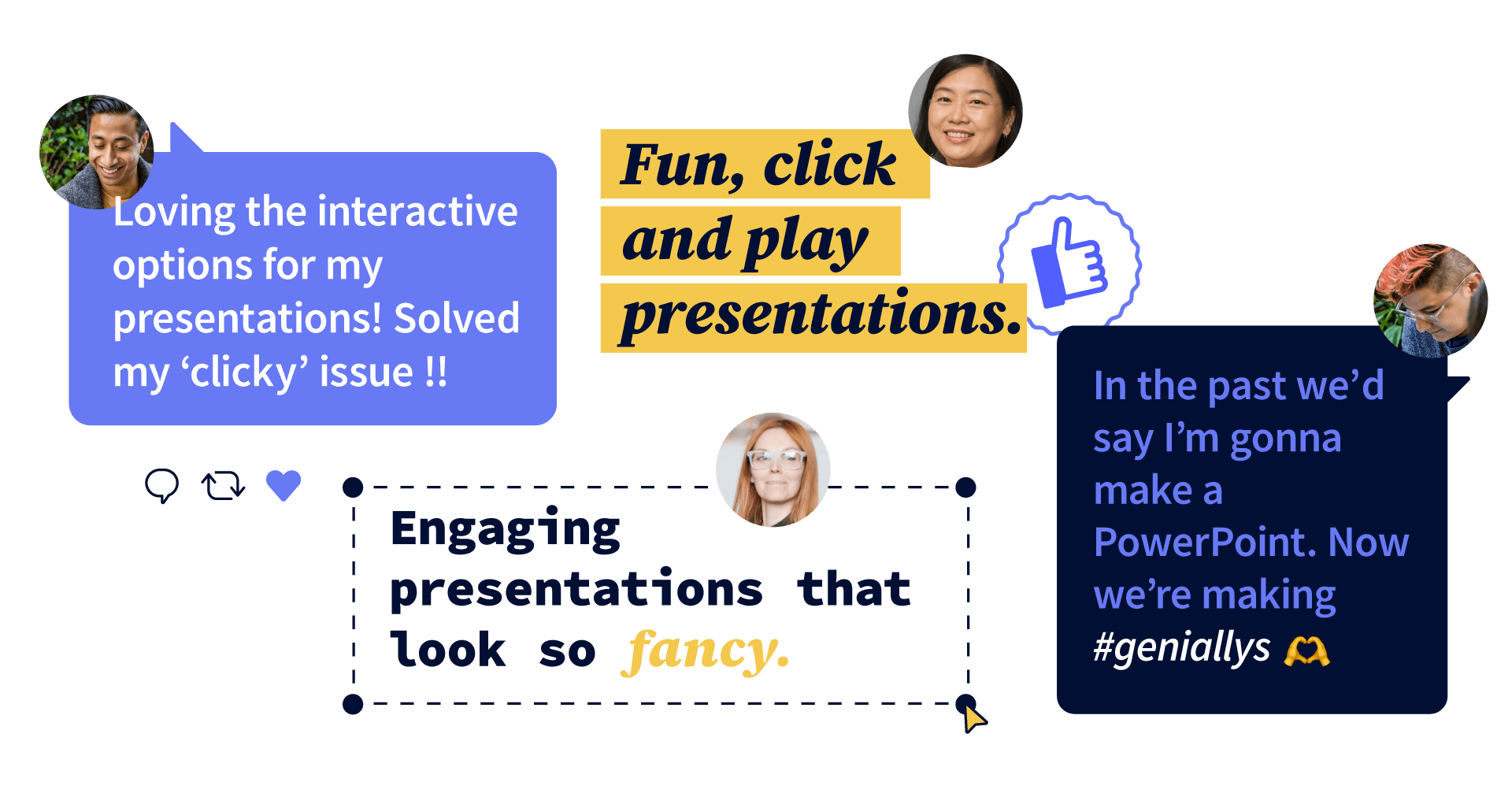
Share anywhere
Present live
From the front of the room or behind a screen, you’ll wow your audience with Genially. Heading off grid? Download in HTML to present dynamic slides without WiFi.
Share the link
Every Genially slide deck has its own unique url, just like a website! Share the link so that others can explore at their own pace, or download an MP4 video slideshow or PDF.
Post online
Embed the slides on your website or post them on social media. Upload to Microsoft Teams, Google Classroom, Moodle or any other platform.

The benefits of interactive slides
🗣️ Active participation An interactive slide deck gives your audience cool things to click on and discover, boosting learning and engagement.
👂 Multi-sensory experience Audio, video, animations, and mouse interactions make your content immersive, entertaining and accessible.
🧑🤝🧑 People-friendly format Pop-ups and embeds condense more material into fewer slides so you can break information down into digestible chunks.
🎮 Gamification Games, quizzes and puzzles make information more memorable and enable you to gather feedback and check understanding.
How to make an interactive presentation
With Genially’s easy-to-use presentation platform, anyone can make incredible visual content in moments.
Choose a template or a blank canvas

Get stunning results in less time with a ready-made template. Feeling creative? Design your own slides from scratch.
Customize the design
Add animations and interactions
Resources to become a pro presentation creator

How to create an interactive presentation: Get started in Genially.

How to present data without sending your audience to sleep.

No-code animation: Bring your slides to life with cinematic visual effects.

The art of digital storytelling: Engage and thrill on screen.
Genially in a nutshell
How do I make a presentation interactive and how does Genially work? Find the answers to all of your slide-related questions here!
What’s an interactive presentation?
Interactive slides contain clickable hotspots, links, buttons, and animations that are activated at the touch of a button. Instead of reading or watching passively, your audience can actively interact with the content.
Genially’s interaction presentation software allows you to combine text, photos, video clips, audio and other content in one deck. It’s a great way to condense more information into fewer slides.
If you’re a teacher, you can share multiple materials in one single learning resource. Students can create their own projects using digital media and online maps. For business or training, try embedding spreadsheet data, PDFs, and online content directly in your slides.
An interactive slide deck is more user-friendly than a Microsoft PowerPoint presentation or Google Slides document. That’s because you can break information down into chunks with pop-ups, labels, voiceovers and annotated infographics.
The other benefit of interactive content is increased engagement. It’s easier to keep your audience’s attention when they’re actively participating. Try Genially’s presentation software and free slideshow maker to see how it’s better than other presentation websites. You won’t go back to standard presentation apps!
How do you make a clickable slide?
The best way to make slides clickable is to use Genially’s free interactive presentation program. Design your slide then apply an interaction. In a couple of clicks, you can add popup windows, hyperlinks, close-up images, games, animations, multimedia and other content.
Choose from the library of hotspot buttons and icons to show people what to click on. Go to Presenter View to get a preview and see how your content will appear to your audience.
How do I create presentations that look professional?
You’ve got a deadline looming and you’re staring at the screen with a blank presentation. We’ve all been there! Starting a presentation design from scratch is tricky, especially if you’re short on time.
Genially’s free online presentation maker has over 2000 ready-to-use templates for professional slide presentations, photos slideshows, and more. Each slide design has been created by our team of top graphic designers. No need to worry about fonts, centering images, or designing a matching color scheme. It’s all done for you.
Start by browsing our layouts and themes for education, business and then customize with your own text and images.
How do I share or download my slides?
Because Genially is a cloud based presentation software, you can simply share the link to your slides. Like other online presentation tools, there are no files to download or store on your computer. Everything is saved online.
When you publish your slide deck, it gets its own unique url, just like a website. Share the link with others to let them explore the content in their own time. If you’re presenting live, just click the Present button.
You can also embed your presentation on your website, company wiki, or social media. Genially is compatible with WordPress, Moodle, Google Classroom, and other platforms. If you use an LMS, you can also download your interactive design slides in SCORM format.
For slideshow videos and slideshows with music, share online or download as an MP4 video. Check out our free slideshow templates for ideas.
Can I make a free presentation in Genially?
You bet! Genially is an easy-to-use slide maker, with a free version and paid plans. The free plan allows you to create unlimited slides with interactions and animations. Subscribe to one of our paid plans for more advanced features.

Discover a world of interactive content
Join the 25 million people designing incredible interactive experiences with Genially.
- Create a presentation Article
- Save Article
- Design Article
- Share and collaborate Article
- Give a presentation Article
- Set up your mobile apps Article
- Learn more Article

Create a presentation
Create a presentation in PowerPoint

Create presentations from scratch or start with a professionally designed, fully customizable template from Microsoft Create .
Open PowerPoint.
In the left pane, select New .
Select an option:
To create a presentation from scratch, select Blank Presentation .
To use a prepared design, select one of the templates.
To see tips for using PowerPoint, select Take a Tour , and then select Create , .

Add a slide
In the thumbnails on the left pane, select the slide you want your new slide to follow.
In the Home tab, in the Slides section, select New Slide .
In the Slides section, select Layout , and then select the layout you want from the menu.

Add and format text
Place the cursor inside a text box, and then type something.
Select the text, and then select one or more options from the Font section of the Home tab, such as Font , Increase Font Size , Decrease Font Size , Bold , Italic , Underline , etc.
To create bulleted or numbered lists, select the text, and then select Bullets or Numbering .

Add a picture, shape, and more
Go to the Insert tab.
To add a picture:
In the Images section, select Pictures .
In the Insert Picture From menu, select the source you want.
Browse for the picture you want, select it, and then select Insert .
To add illustrations:
In the Illustrations section, select Shapes , Icons , 3D Models , SmartArt , or Chart .
In the dialog box that opens when you click one of the illustration types, select the item you want and follow the prompts to insert it.

Need more help?
Want more options.
Explore subscription benefits, browse training courses, learn how to secure your device, and more.

Microsoft 365 subscription benefits

Microsoft 365 training

Microsoft security

Accessibility center
Communities help you ask and answer questions, give feedback, and hear from experts with rich knowledge.

Ask the Microsoft Community

Microsoft Tech Community

Windows Insiders
Microsoft 365 Insiders
Find solutions to common problems or get help from a support agent.

Online support
Was this information helpful?
Thank you for your feedback.

- SUGGESTED TOPICS
- The Magazine
- Newsletters
- Managing Yourself
- Managing Teams
- Work-life Balance
- The Big Idea
- Data & Visuals
- Reading Lists
- Case Selections
- HBR Learning
- Topic Feeds
- Account Settings
- Email Preferences
How to Make a “Good” Presentation “Great”
- Guy Kawasaki

Remember: Less is more.
A strong presentation is so much more than information pasted onto a series of slides with fancy backgrounds. Whether you’re pitching an idea, reporting market research, or sharing something else, a great presentation can give you a competitive advantage, and be a powerful tool when aiming to persuade, educate, or inspire others. Here are some unique elements that make a presentation stand out.
- Fonts: Sans Serif fonts such as Helvetica or Arial are preferred for their clean lines, which make them easy to digest at various sizes and distances. Limit the number of font styles to two: one for headings and another for body text, to avoid visual confusion or distractions.
- Colors: Colors can evoke emotions and highlight critical points, but their overuse can lead to a cluttered and confusing presentation. A limited palette of two to three main colors, complemented by a simple background, can help you draw attention to key elements without overwhelming the audience.
- Pictures: Pictures can communicate complex ideas quickly and memorably but choosing the right images is key. Images or pictures should be big (perhaps 20-25% of the page), bold, and have a clear purpose that complements the slide’s text.
- Layout: Don’t overcrowd your slides with too much information. When in doubt, adhere to the principle of simplicity, and aim for a clean and uncluttered layout with plenty of white space around text and images. Think phrases and bullets, not sentences.
As an intern or early career professional, chances are that you’ll be tasked with making or giving a presentation in the near future. Whether you’re pitching an idea, reporting market research, or sharing something else, a great presentation can give you a competitive advantage, and be a powerful tool when aiming to persuade, educate, or inspire others.
- Guy Kawasaki is the chief evangelist at Canva and was the former chief evangelist at Apple. Guy is the author of 16 books including Think Remarkable : 9 Paths to Transform Your Life and Make a Difference.
Partner Center

Interactive Business Presentation Design
About the project, place your bid, benefits of bidding on freelancer.

About the client

Client Verification
Similar jobs.

COMMENTS
Action Buttons: With hyperlinks, you can also create Action Buttons in your PowerPoint presentations to make your PowerPoint slides behave like interactive web pages, allowing users to navigate, explore, and engage with the content in a dynamic and user-friendly manner. Head over to Insert > Action Buttons and choose from the selection.
Avoid unnecessary animations. Only add content that supports your main points. Do not use PowerPoint as a teleprompter. Never Give Out Copies of the Presentation. Tips To Making Your Presentation More Engaging. Re-focus the attention on you by fading into blackness. Change the tone of your voice when presenting.
Click on the object you want to use as a hyperlink (or create a shape with no fill and no outline and place it over the area) Go to 'Insert' on the navigation ribbon and click 'Hyperlink'. Select 'Place in This Document' and select which slide you'd like to hyperlink to (see right) Click 'Ok' and you're good to go!
Learn to Create an Interactive Slide Deck in PowerPoint. Navigate through your presentation easily with creative hyperlinks and transitions. Link to PowerPoi...
Creating more interactive powerpoints couldn't be easier! In this interactive PowerPoint presentation tutorial, I show you how to create interactive buttons...
1 Start your interactive presentation with an icebreaker. The first step is creating a rapport with your audience. You can do this by helping them to get to know you a little better and get to know each other as well. The way you go about this will depend on the size of your audience.
Create an interactive PowerPoint with these 10 tips, all using 1 tool that integrates seamlessly into PowerPoint - ClassPoint! With AI, Interactive questions...
Once you've chosen your element, right click and choose the option Link. A pop-up window will appear and on the left hand side you want to choose the option Place in This Document. A list of your slides will then appear. Choose the one you want to link to, hit OK and you're sorted. Remember - you can use hyperlinks in PowerPoint in all ...
How to Create an Interactive Presentation Tab Bar Using MS PowerPoint. To create a tab bar, you need to thoroughly design the first tab. Go to Insert tab and click the Shapes button in Illustrations group. The drop down menu will appear. Select Rectangle shape in the Rectangles option.
3. Six Thinking Hats PowerPoint Template for Interactive Presentations. Induce interactive activities for presentations by implementing this creative thinking template featuring the Six Thinking Hats model. It is ideal for teams to discuss a problem from different points of view. Use This Template.
Whether you're an educator, a business professional, or a student, making your PowerPoint presentation interactive can elevate it to the next level. In this guide, we'll walk you through the steps to create an interactive PowerPoint presentation and introduce you to a game-changing tool: the AI PowerPoint generator by Smallppt. 1.
Here are five things you can do using Slides With Friends to make an interactive slide deck presentation. 1. Incorporate Icebreaker Polls. Polls are a fantastic way to break the ice with your group and get them talking. This interactive strategy is especially great if your audience doesn't know each other well.
Here are some of the most common ways to add interactivity to your PPT slides: PowerPoint triggers and animations. Multimedia: visual content, audio files, web pages, and videos. Interactive software simulations. Mini games. eLearning interactions. Interactive quizzes. Interactive role-play simulations.
5. Re-engage your audience every 5-7 minutes. Keep the momentum and motivate your audience to "talk" to you throughout your presentation. Even if it is just in a non-verbal way. We recommend using live polls or other forms of interaction every 5-7 minutes to pull people back in and involve them in a conversation.
Step 3 - Add interactions. Once you've got your PPT slides in your presentation, you can now add the interactive portions. Each interaction is added like a new slide to your deck. So for instance, if you want to add a Poll question to a PPT slide, this would be a new slide that you would place directly after your static PowerPoint slide.
Use humor. Showing your personality and sense of humor can lighten the mood and build a good rapport with the crowd. The audience is more likely to remember you if you make them laugh and in turn remember your ideas and key points. 6. Eye contact. The power of good eye contact can never be underestimated.
In his video I show you how to make an Interactive PowerPoint Presentation! We'll use the Morph Transition in PowerPoint to make a creative presentation. Thi...
On the Start Page, click Import PowerPoint > browse and select the PowerPoint file you want to import. In the workspace, click the ActivePresenter button (1) > Import PowerPoint (2) > select the PowerPoint file on your computer. Read this full tutorial here for more information about how to import. But, before importing your PPT presentation ...
For an effective PowerPoint presentation, stick to the 5/5/5 rule: limit yourself to 5 words per line, 5 lines or bullet points per slide, and 5 text-heavy slides in a row. This will help you keep your slides concise and focused while avoiding overwhelming your audience with too much information. These guidelines can be a valuable tool for ...
Select the Object You Want to Animate Click on the text box, image, shape, or chart you wish to animate. Access the Animation Tab Navigate to the 'Animations' tab in the PowerPoint ribbon to ...
Make interactive presentations. Create show-stopping presentations and clickable slide decks with Genially's free online presentation builder. Leave boring behind and tell a story that's interactive, animated, and beautifully engaging. Make an interactive presentation.
Open PowerPoint. In the left pane, select New. Select an option: To create a presentation from scratch, select Blank Presentation. To use a prepared design, select one of the templates. To see tips for using PowerPoint, select Take a Tour, and then select Create, . Add a slide.
You can use the steps in this video to create an interactive PowerPoint presentation, using almost any version of PowerPoint.A reason to know how to create i...
When in doubt, adhere to the principle of simplicity, and aim for a clean and uncluttered layout with plenty of white space around text and images. Think phrases and bullets, not sentences. As an ...
Open a new Microsoft PowerPoint. Click the Copilot button from the top bar. This will open a Copilot section from the left pane. Now, you can start creating a presentation by asking Copilot to ...
Interactive PowerPoint lessons are a great way to keep students engaged as you teach! In this edtech tutorial, you'll learn how to make interactive PowerPoin...
Happy to design compelling and persuasive Presentation on PowerPoint with perfect theme, branding and logo. Presentation will be well organised and easy to use for presenter. I can provide…. $30 USD in 1 day. 4.9 (29 reviews) 5.3. 5.3. Graphic Design & Corporate Identity Projects for $10-30 USD.
After make this, you can use this ppt slide on your PC, or copy to andro... This video show you how to make an interactive PowerPoint presentation step by step.